
The Retrogaming Times
- The Bimonthly Retrogaming Hobbyist
Newsletter -

The Retrogaming Times
- The Bimonthly Retrogaming Hobbyist
Newsletter -
| The Retrogaming Times |
|
|
Ahead lies the most diverse and packed issue we've yet to present. If you enjoy reading The Retrogaming Times, consider submitting an article of your own! Contact me directly at trt@classicplastic.net and join us as part of a great retrogaming tradition. Additionally all our readers should know about The Retrogaming Times on Facebook at facebook.com/theretrogamingtimes! If you have comments or questions about anything covered in the newsletter or there is something you would like featured in The Retrogaming Times, let us know there. We also publicly post upcoming issue information, news, contests, giveaways and more, including content outside the realm of the publication. If you want to keep in the know, then join our new community on Facebook today.
Last issue's cover story, the homebrew Commodore 64 game SHOTGUN, has finally been released as a "Boxed Version" and the official website at http://shotgun.drwuro.com has been updated with all the details. This issue's More C64! has additional information along with other C64 homebrew games recently released on physical media. The Controller Chronicles takes a look at the NES Controller, which featured the continuing evolution of the directional pad. I have always felt that the humble directional pad is the single most important innovation in the history of the home video game industry. While using buttons aligned with the cardinal directions for movement in video games was used as early as 1976, and Cosmic Hunter on the Microvision used a flat surface to tie the directional buttons together in 1981, it was the release of the Donkey Kong Game & Watch handheld in 1982 that gave us the first true directional pad. The directional pad, along with the Game & Watch series that first used it, was one of many practical innovations born from the genius of the late Gunpei Yokoi. The idea was to find a way to facilitate smooth directional movement for Nintendo's line of reasonably thin handheld LCD games, essentially a way to create a flat joystick. Realizing it was also the perfect control input for handheld console controllers, as it provided the most comfort and flexibility, Nintendo utilized it as the standard directional control for the Famicom in 1983 and the NES in 1985. Of course it was later implemented in one way or another by nearly every home video game console to this day.
In this issue's cover story, Retrogaming
Feels recalls a first experience with the Atari VCS classic Yars' Revenge,
in a piece that brings to mind the amazement new games hold - especially
when they feature something surprising or innovative. The long running
Apple II Incider returns after an issue away, with expectations and disappointments
concerning Sundog: Frozen Legacy. California Extreme 2016 is looked
back upon, celebrating its twentieth consecutive year as the premier Bay
Area arcade and pinball collector's show. We have an interesting
and detailed interview with professional gaming and undeniable eSports
icon TriForce Johnson. Some gold is struck with the next fifteen
games on the CoolBoy 198 in 1 Famicom pirate multicart, but the good isn't
without some garbage as the journey continues. All that and more
is ahead as we welcome you to this issue of The Retrogaming Times.
|
A Video Game Con (AVGC), September 10th - 11th 2016, Parsippany, New Jersey, USA
A Video Game Con (AVGC) is NJ's premiere convention dedicated to both retro and modern video games. The convention will feature professional and casual tournaments, musical performances, video game burlesque, console freeplay, indie video game developers, special guests, cosplay contests, vendors, panels, auctions/raffles, and MORE! Our second annual event will take place across two days this year, September 10th and 11th, 2016. AVGC is committed to hosting a full convention experience dedicated to both retro and modern video games!
For more information and to purchase tickets, visit http://www.avideogamecon.com/
~ ~ ~
Retropalooza, October 1st - 2nd 2016, Arlington, Texas, USA
A celebration of all things retro! Retropalooza was started in 2013 in Arlington, Texas by a couple of guys who enjoy all things retro; from toys to music, to video games... especially video games. As video game collectors, they spent a lot of time and money looking for retro games when they figured it would be easier to bring the games to them. Thus, Retropalooza was born.
The goal of Retropalooza is to bring nerds from all walks of life together for an enjoyable, family friendly time. Good old fashioned fun with like minded people where it will always be affordable, and forever improving.
For more information, visit http://retropalooza.com/
~ ~ ~
Retro World Expo 2016, October 15th - 16th 2016, Wallingford, Connecticut, USA
RetroWorld is a video game related Expo held annually in Connecticut. It is a celebration of Classic and Retro Video Gaming that also embraces Tabletop Gaming, Modern Video Gaming, Homebrew Gaming, Anime, Action Figures, Comic Books, Cosplay, Arcade Machines, and much more.
The first Annual RetroWorld Classic Gaming Expo took place at Toyota Oakdale Theatre in Wallingford, CT with a 22,000 square foot convention hall with two side rooms of 4000 and 2000 square feet respectively. The convention hall accommodated more than 70 exhibitors and over 2,000 classic fans and attendees. The two side rooms were used for gaming related panels and a large console and arcade area. RWX returns in 2016 with even MORE with a two day event to expand the overall fun and enthusiasm from the incredibly successful inaugural event.
For more information, visit http://retroworldexpo.com/
~ ~ ~
Portland Retro Gaming Expo, October 21st - 23rd 2016, Portland, Oregon, USA
2016 will mark the 11th annual Portland Retro Gaming Expo to be held at the Oregon Convention Center on October 21-23, 2016. The event occupies over 90,000 square feet with more panels, more exhibitors and more games than ever before.
Retro Gaming Expo, Inc. is a Portland, Oregon-based 501(c)4 non-profit cooperative organization dedicated to creating awareness of, and appreciation for classic video and arcade games through the presentation of events and conventions that celebrate the historic contribution video games have made and continue to make in popular culture.
For more information and to purchase tickets, visit http://www.retrogamingexpo.com/
~ ~ ~
Return of the Pacific Pinball Exposition, November 10th - 13th 2016, Alameda, California, USA
The Pacific Pinball Museum presents the largest collection of working pinball machines from the 1930s to present day with this year's "Shoot The Moon" Pacific Pinball Expo honoring the Golden Age of Pinball. Housed in our new storage facility at Alameda Point (1680 Viking Street, Alameda), this is our biggest show yet!
This three-day Pinball extravaganza will add up to an amazing experience that is fun for the whole family. The Pacific Pinball Expo (PPE) is just a quick walk to the Hornet Aircraft Carrier Museum, and a short drive to restaurants, hotels and beautiful Alameda beaches.
All proceeds benefit the efforts of the Pacific Pinball Museum, a 501(c)3 non-profit dedicated to pinball preservation and fun!
For more information and to purchase tickets, visit http://pacificpinball.org/events/return-pacific-pinball-exposition-7
~ ~ ~
Sac Gamers Expo, December 11th 2016, Sacramento, California, USA
A video game convention featuring special guests, panels, work shops, vendors, food trucks, displays, artists, game developers, tournaments, console gaming room, viewing room, video game museum, video game music and so much more! Sac Gamers Expo is a family oriented event for all levels of gamers.
For more information and to purchase tickets, visit http://www.sacgamersexpo.com/
~ ~ ~
Pintastic Pinball & Game Room Expo, July 6th - 8th 2017, Sturbridge, Massachusetts, USA
Do you love pinball? Are you looking for a little relief from the hot summer sun? Look no further than Pintastic New England, which is the first of its kind, centrally located in Sturbridge, Massachusetts. This expo is 30,000 square feet of fun for the whole family. The kids can have never-ending excitement with a caricature artist, face painting, balloon animals, magic, and relieve all of their pent-up energy with a bouncy house. The adults can bring out their inner child with over 200 pinball machines set on free play, all while enjoying an ice-cold beer.
For more information, visit https://pintasticnewengland.com/
~ ~ ~
If there is a show or event you would like listed here, free of charge, please contact David directly at trt@classicplastic.net. Please include a short official blurb about your event along with any relevant links or contact information and it will be published in the next issue of The Retrogaming Times. The event listing will remain posted until the issue following the event date.
Check out these great events, shows,
and conventions and let them know you read about them in The Retrogaming
Times!
|
Welcome back to the world of the Commodore
64, and this time we are looking at some recent new releases on physical
media.
AKALABETH
Many early computer games drew their inspiration from Dungeons & Dragons, and Richard Garriott was a young programmer who did just that. Akalabeth was published for the Apple II in 1979, first as a tape in a Ziploc bag then later as a properly boxed product. The significance of the release increased when Garriott (known by his nickname Lord British) went on to create the Ultima series of games and the company Origin. Garriott even became a space tourist, following in the footsteps of his father Owen.
So in 2016 a conversion of the original Akalabeth (sometimes referred to as Ultima Zero) was announced for the Commodore 64. Dungeoneer Games, an Italian group, showed preview pictures and opened orders for a limited edition of just 50 disks. These sold out in just 3 hours, and I was lucky enough to secure a copy.
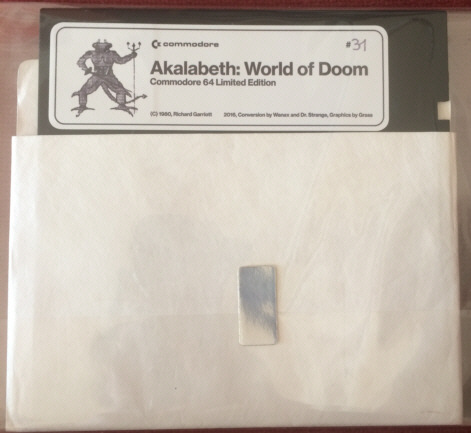
Number 31 of the 50 limited
edition copies of Akalabeth
The land of Akalabeth was blighted by the evil lord Mondain, and now Lord British is asking for an adventurer to clear the lands of the foul monsters left behind. The first step is to create a character. The player chooses their lucky number (used as a seed for the dice rolls) and the level of play (1-10, with 1 being easiest). The dice are rolled and the stats shown -- Hit Points, Strength, Dexterity, Stamina, Wisdom and starting Gold. These can be rolled again if not happy, and then either a Fighter or Mage chosen. A Mage can use the Magic Amulet but not certain weapons, and the Fighter cannot use the Amulet. The Shop allows players to buy weapons and food before starting out. (Tip: buy plenty of food, a Magic Amulet if you are a Mage and a weapon if you are a Fighter.)
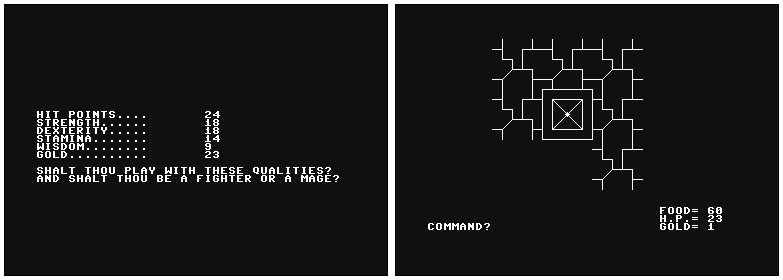
Rolling the dice for
a character in Akalabeth before choosing Fighter or Mage (left)
Lord British waits in
his castle surrounded by mountains (right)
The game then generates a random landscape, filled with towns, dungeons, mountains and Lord British's castle. The player starts at a random town. Moving through the overworld, mountains block the path. Going into a town gives a shop to buy and sell supplies. Lord British is waiting in his castle, allowing you to name your fighter and accept a quest -- for a boost in your stats. Entering a dungeon is where the game really begins.
Each dungeon is shown in a basic first-person view. Chests on the floor contain gold, weapons and food. Ladders lead up and down between levels and there are traps that can drop the player down a level. Enemies including the sneaky thief, giant rats and the nasty mimic await. The player can try and move away, or attack with the current weapon (or magic from the amulet). Running out of hit points or food brings the adventure to a close.
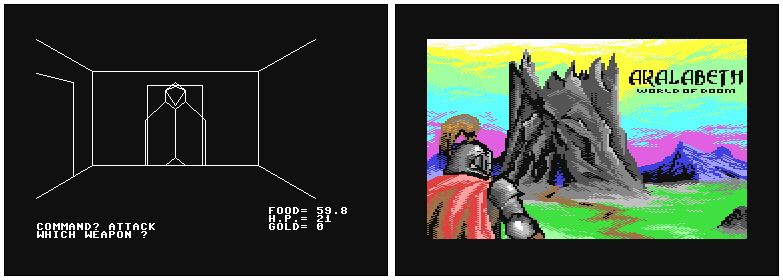
The thief attacks in
the dungeon (left), The bitmap introduction to Akalabeth on the C64 (right)
This is a very faithful conversion, right down to the text prompts and graphics. The only major addition was a series of bitmaps that act as an introductory sequence if the player asks for the instructions. It is of course a lot simpler than the Ultima games that followed, but you can see the roots of the role-playing genre shine through. The (free) download of the game will be available shortly.
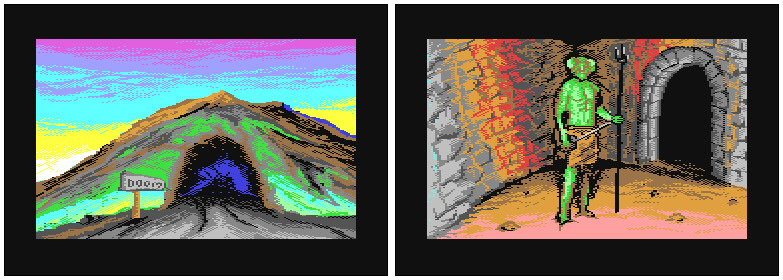
The bitmap introduction
to Akalabeth on the C64
WEB LINK
http://dungeoneergames.altervista.org/akalabeth-64-project-update/
- The latest news on the game.
SHOTGUN
An interview with Shotgun's creator Christian Gleisner featured in our last issue of Retrogaming Times, and in it he mentioned plans for a physical release of the game. Once again I was lucky enough to order a copy, and I already owned the Classical Games 4-player adapter (currently available from Protovision).
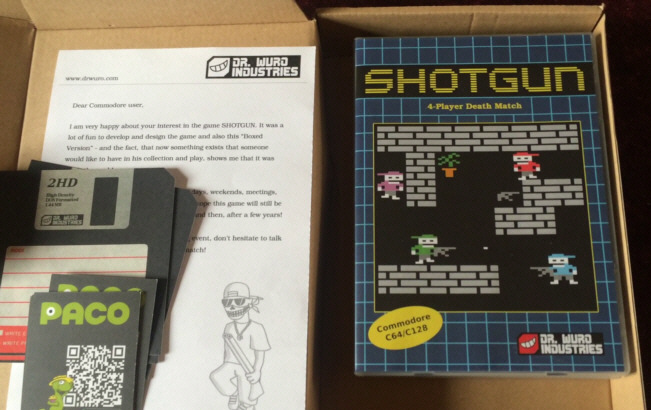
The Shotgun package includes
postcards, a pin badge, the large plastic case and the 5.25" floppy disk
The game itself is designed for 2-4 players. In emulation, the VICE emulator can simulate the adapter. On the menu there are several options that can be changed, including the number of players. The number of kills needed to win a round, the arena (from seven available) to play in, the colour scheme (affects the wall and control panel colours) and whether the music is on are all selectable.
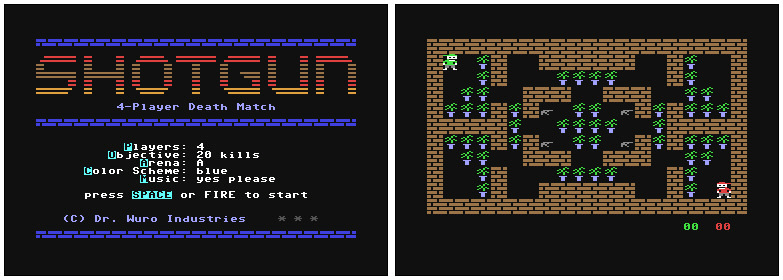
Choosing the options
in Shotgun (left), Arena G is known as the garden due to the large number
of plants that make it harder to see the players (right)
Once the game starts, the players appear at the four corners of the maze. They must find a gun, which holds three bullets. Once the three bullets are fired, the player loses a gun and must pick up another; a used gun returns to the arena after a short delay. The player fires in the direction they are moving in, or the last direction moved if standing still. The counters at the bottom of the screen keep a tally of the hits. At the end of the game, the number of kills each player has achieved is shown and the game returns to the menu.
Shotgun was designed for multiple players at a party, and that is the best way to play. The graphics are simple but effective, and the choice of arena adds some variety. There is a free download available, as well as the nicely packaged boxed version.
WEB LINK
http://shotgun.drwuro.com/
- The website to download the game or order a boxed version.
BARNSLEY BADGER
To round off the column this month, we have the platform game Barnsley Badger. This was inspired by the classic game Monty on the Run, and was initially only available in an "Ultimate Edition" through the Kickstarter campaign for a C64 book (The Story of the Commodore 64 in Pixels, published by Fusion Retro Books). Now the game is on general sale -- with simpler packaging or as a digital download - from Psytronik in the UK.
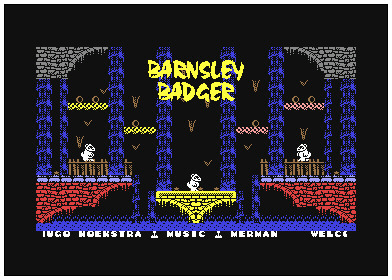
The title screen from
Barnsley Badger
The game design and graphics are by Trevor Storey (Smila), the coding is by Georg Rottensteiner and the music is composed by... The writer of this column. While the game was in development I approached Trevor and asked if I could be involved. I had an existing piece of music (with five different subtunes) that fitted the game perfectly. With some editing to remove unwanted subtunes and to reduce the memory used, the title tune and in-game music went into the game. Another existing tune of mine was chosen and used for the tape loading sequence. On disk this was used in a separate introductory load, showing the beautiful bitmap loading screen Trevor had created.
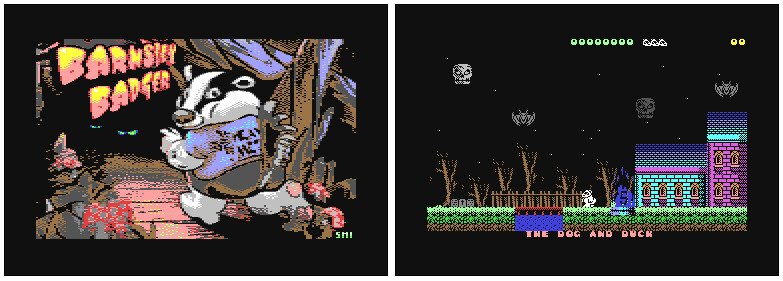
The loading screen from
Barnsley Badger (left), The first screen of Barnsley Badger's adventure
to find the six golden coins (right)
Barnsley must hunt through the locations filled with enemies and hazards to find six golden coins. There are large angry dogs, sewer-dwelling mutants and others intent on stopping him. On the way he will need to find the coloured keys to unlock doors and other useful equipment. This includes the catapult (to shoot enemies with) and the trainers (to enable the double jump and reach higher platforms). Once the six coins are placed on their plinths, Barnsley heads down the unlocked ladder to the finish.
Barnsley is a really fun game, with graphics that echo classic platform games from the 1980s. Trevor and Georg have now finished their new project, MY LIFE, inspired by the classic coin-op game Mikie. This is also available from Psytronik.
WEB LINKS
https://psytronik.itch.io/barnsley-badger-c64 - Order a digital download from the itch.io store here.
http://binaryzone.org/retrostore/
- The Binary Zone Retro Store for ordering physical copies.
Please note the store is open to new orders
from the 1st to the 15th of each month. Links for current digital downloads
will be displayed on the "closed" shopfront.
|
It's time again to get in touch with your feels - your retrogaming feels, that is! Join me as I visit my most memorable gaming experiences and discuss the games in terms of how I felt when I played them. This issue I'll be discussing a well known classic from the Atari 2600 library, Yars' Revenge.
Although Yars' is quite well known, and well loved by many, it isn't usually the first game that comes to mind when people talk about the Atari 2600. The 2600 went from being a sales dud to stud thanks to Space Invaders - and from that point forward Atari marketing focused on bringing the arcade hits home. This happened with varying degrees of success, of course. People love to talk about the bitter disappointment of 2600 Pac-Man as much as they love to reminisce over the hours of fun they had playing their Missile Command and Berzerk cartridges.
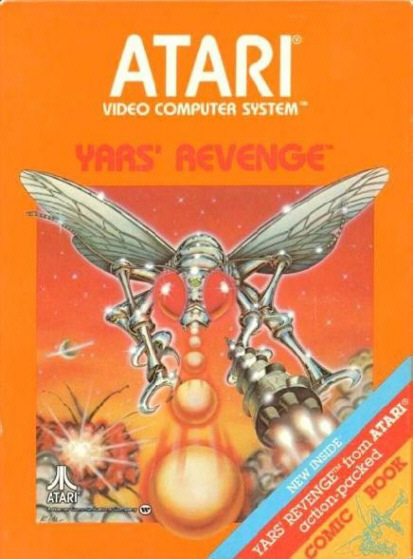
The fact is, as much fun as we all had playing these arcade hits at home, they were only watered down versions of the arcade originals. The 2600 hardware simply wasn't capable of replicating the experience provided by arcade hardware that was far superior (and improving all the time). Atari programmers often faced the daunting task of trying to pare down an arcade hit to fit into the confines of the 2600, taking pains to preserve the gameplay if not the looks and sounds of the original. There were probably times when they said a game simply couldn't be done on the 2600, then they would turn around and do it anyway.
This was what was supposed to happen when a programmer named Howard Scott Warshaw was assigned the task of creating a 2600 version of Star Castle. Warshaw quickly came to the conclusion that the 2600 simply wasn't well-suited to the demands of Star Castle, and the best he'd be able to do would be a pale imitation. I think most people would have done just that - and maybe the 2600 version of Star Castle would take its place next to Pac-Man in the list of lackluster arcade ports on the system. Warshaw didn't do that, though. He decided he'd instead make a game tailored to the hardware, one that worked right along with its capabilities and played to its strengths, rather than trying to overcome its limitations. Yars' does borrow gameplay elements from Star Castle, but is enough of a departure that it stands on its own.
I first played Yars' at a friends house. At the time, every new game was cause for excitement - so I'm sure the fact that the title wasn't familiar was of little concern. There was a small group of us gathered in front of the large console television in my friend's living room. One of his two older brothers were playing when I got there - and the two older kids alternated turns between themselves for a while, only surrendering the controller to my friend or myself after a careful reminder from their mother about sharing. Younger kids everywhere know all too well the struggles of waiting for their turn to play.
With Yars' the wait was not as painful as usual. I was entranced by the game - it was almost as much fun to watch as it was to play. I was filled with a sense of wonder as I drank in sights and sounds of this new game. The shimmering field in the center of the screen was the first thing that caught my eye - it seemed to crackle and spark, always in motion. It looked like the static that was on the screen before you flipped the power switch on the Atari, but more controlled. I wondered to myself how there could be static on the same screen with the game.
To the right sat what appeared to be a spaceship, ensconced by a solid red triangular shield. The ship's color cycled through varying degrees of white and gold, while a constant low undulating thrumming sound, which matched the pulsing of the ship, emanated from TV . The ship seemed quite alive - and ominous - despite it being a static image.
To the left, what appeared to be a moth-like creature flitted about the screen rapidly. A small missile, pulsing color matching that of the spaceship, slowly traveled around the screen in pursuit of the moth. At first it seemed easy to avoid, but it was quite relentless. The moth would dart towards the shield, chipping away at it for a moment before leaving again to lure away the missile that tracked its every move. The shield got smaller and smaller as the moth ate holes in it. The moth could shoot little projectiles at the shield as well - though the tiny bullets were useless against the ship. I asked what it was, and my friend quickly explained that the moth like thing was "you" - and that "you" needed to shoot the ship with your Zorlon cannon to proceed to the next level. "Zorlon cannon?" I asked. "The little bullets aren't the cannon?" A shake of the head was all I got. They were watching intently, so I did too.
On occasion, the ship would transform suddenly in a red swirl - the was accompanied by a high pitched siren like sound. It would spin in place for a moment, then hurl itself towards the moth at high speed. Contact meant death for the moth, a miss meant the ship would reappear, pulsing and waiting for another chance to strike. I saw the older brother meet his end in this way, the moth shrinking down to a dot with a whimper from the TV and a curse under the player's breath. It all seemed quite tense - touching the ship with the moth was fine, but touching the swirl was not, and it seemed that the ship could become the swirl at any moment. I got nervous whenever the moth got close to the ship.
All of this happened in only a couple of minutes or so. On Atari, life comes at you fast. I was desperately trying to understand what was going on. I wanted to be ready when it was my turn - I didn't want my game to be over too quickly, as it would likely be another long wait until I got to play again. I also didn't want to look bad in front of the older kids. There was always a bit of performance anxiety for me when playing in front of a crowd of kids waiting their turn at the arcade, and although this group was only my friend and his two older brothers, I still felt a bit nervous.
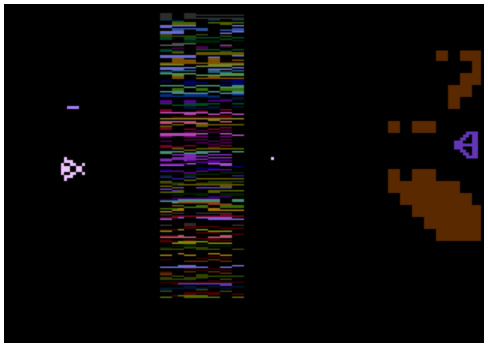
I saw that occasionally a larger projectile would travel quickly from left to right. I saw it chip away at the shield, and also saw it destroy the moth. That was the Zorlon cannon, I was told. So the weapon could kill both the player and the enemy - this game was looking more difficult by the minute. I was trying to understand how it was being fired when it made contact with the red swirl - and that was when I saw a beautiful sight. The entire screen lit up, filled with a pulsing scrambled glow of pixels accompanied by a terrific explosion sound. It was clear that a great thing had just happened - and I immediately wanted to make that happen myself. The apprehension about playing went away, I was ready for my turn. The explosion sequence, simple as it may be, is a great reward. To this day, I get a little jolt whenever I see it. On a tube TV, the image seems to push the edge of the display outward just a bit when it appears, shrinking back as the explosion smoothly dwindles from full-screen to a single horizontal line. You can almost hear the TV breath a sigh of relief when it is over, replaced by a still and silent display of the player's score and lives remaining.
After the three siblings had played a couple of turns, I got my chance. I learned that the static field in the center was a safe haven from the slow moving missile, but not from the swirl. I learned that there were other game variations that made things even tougher. I saw the shield change colors as the older kids blasted their way past several Qotile. Oh, and I learned that the enemy ship was called a Qotile. I didn't get to the wonderful explosion on my first try, but it wasn't long before it became a regular occurrence. Each time felt victorious - and hitting the Qotile when it streaked towards us in swirl form was even more rewarding, both in score and in feeling.
This little reward system, along with the tight controls, a wide range of difficulty, and just enough randomness to keep things fresh, have kept me coming back to Yars' for many years. Mario gets his fireworks when he reaches a castle, Link raises his hands triumphantly when he gets a piece of the Triforce, and Yars' Revenge give you the satisfaction of knowing you just completely annihilated the bad guys.
To me, this game more than any other is quintessential Atari. It is a technical achievement, just barely squeezing into the 4 kilobyte limit the 2600 can recognize without any special chips. The overall design is elegant and flashy at the same time - presenting everything needed to fully engage the player without pushing the machine past its limits. There is no trace of sprite flicker, no bum notes from songs that aren't suited to the hardware, and no sign of the HMOVE lines that plague so many 2600 titles. It has enough depth that it begs many replays, but remains completely approachable. The “Easy to learn, hard to master” Atari approach to design shows through here in grand style. Even after hundreds of games, I still find challenge with little frustration. I always feel like I will do just a little bit better if I hit that reset switch just one more time.
Have you never played Yars' Revenge?
You can start here - but you owe it to yourself to play it on the real
thing.
http://atariage.com/software_page.php?SoftwareLabelID=603
There is a wonderful book titled "Racing
the Beam: The Atari Video Computer System" that explains the technical
side of Yars' Revenge, as well as several other 2600 games. I can't
recommend it enough.
https://mitpress.mit.edu/books/racing-beam
|
Welcome to the September edition of The Retrogaming Times. I'm back after a month off. The month off was unintentional! I saw David's note to submit articles but it was a busy time and next thing you know, I get an email indicating that the July issue had been published. Oh well!
This month, I wanted to take a brief look at a game called Sundog: Frozen Legacy.
When I was young, I believe I saw either an advertisement in a magazine or Sundog at a store and was intrigued. The packaging for the game was pretty cool and I imagined Sundog to be a space action / adventure game like Star Fleet I: The War Begins from Interstel.
While I never purchased the game myself, I borrowed a copy from my cousin and gave it a spin. I can't remember exactly when I played the game. According to Wiki, Sundog was released around 1984, so if I played the game somewhere around that time, I would have been around 10 to 12 years old (give or take a year or two).
Even today, I admit I am not the most patient gamer. I like to be able to jump right into a game. So I remember being a little frustrated at what to do with Sundog. You got dropped into your ship and you're maneuvering a little dot around a space ship with little idea of what to do or how to play the game. Thus that was the extent of my initial experience with Sundog.
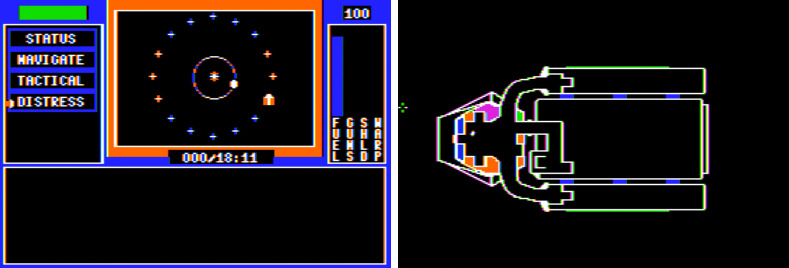
As I look back now, I realize that Sundog was not an action type game like Star Fleet I: The War Begins, though there are apparently some flight simulation / action sequences that I never got to. Sundog was more like a space version of Ultima or other role playing adventure games. I did try to give Sundog a spin before writing this column. Without the manual, I didn't know all the commands but I went through the ship to see what I could do. I tried to warp to another planet but couldn't quite figure out how to do it. The last thing I did was wander into one of the cities. I wandered around and got jumped by someone and killed. That basically concluded my game experience with Sundog.
However, I was intrigued by Sundog enough to read up on the game on the Internet. There's a lot of information including how people were impressed with the Apple II version of the game. Apparently, Sundog was deemed to be very impressive with the graphical user interface that was implemented on the Apple II. It was also interesting to read that one of the main developers Brian Webster worked so hard on the game that he eventually stepped away from developing the sequels as he originally envisioned.
For those with some patience, Sundog may
be worth a spin. There's also an Atari ST version that was released
so fans of the ST series can play the game as well. But if you're
looking for a space simulation / action type game, Sundog isn't for you.
Apple II News
NEW APPLE II LOW-RES GAME IN THE WORKS
A developer posted on the comp.sys.apple2
newsgroup that he was working on a low-resolution graphic action game called
Space 4048. The developer posted a YouTube video with some demo shots
of the game:
https://youtu.be/wKF_gARfMCc
My initial take on the game? A very nice low-res version of the arcade hit Galaga! Especially during the part of the video when the gamer gets a DOUBLE SHIP. It looks really cool. The developer commented on YouTube that development of the game was paused because he had to move for work. Hopefully the developer can get back to things and finish up the game.
STEVE WOZINAK's 66th BIRTHDAY
Per A2 Central, Steve "Woz" Wozniak's 66th
birthday was on August 11th! Happy 66th to the Woz!
http://a2central.com/7207/happy-66th-birthday-woz/
|
Welcome back as we continue our voyage with the CoolBoy Real Game 198 in 1 bootleg Famicom multicart. If this is your first journey with us, a bootleg pirate multicart is a video game cartridge containing multiple games that would otherwise have single cartridge retail releases. Pirate multicarts have become bigger and better over the past couple years. Although these days you have options such as flash memory cartridges if you want to play a bunch of games off a single cartridge, there's just something about these bootlegs that appeal to me. I've found collecting multicarts a fun collecting sub genre since the early to mid 2000's. Two of the currently most popular multicarts are branded under the "CoolBoy" name and are generally known as "198 in 1 Real Game" and "400 in 1 Real Game" and these cartridges are usually sold together as a pair.
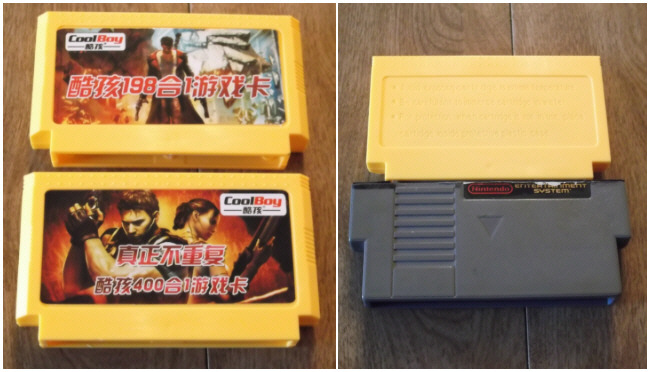
CoolBoy "198 in 1" and
"400 in 1" cartridges along with a custom made Famicom to NES converter
While the 400 in 1 cartridge contains more total games, I find that the 198 in 1 contains a more interesting mix of titles with less filler. This is due to the 400 in 1 cartridge containing more pirate originals including a rather large library of games released by Thin Chen Enterprise, the Taiwanese company better known as Sachen, history's most prolific producer of unlicensed Famicom games. While these games are an interesting collecting sub-genre onto themselves, and a sadly forgotten part of modern NES and Famicom collector culture, they're not necessarily all that fun to play. It should also be said that the back half of the game list for each cartridge is generally filled with these type of Taiwanese and Chinese pirate original games. The 198 in 1 cartridge isn't too bad in this respect, with fifty or so games falling into this category.
This scope of this ongoing column is to quickly evaluate the 198 in 1 cartridge, fifteen games at a time, until the entire list is completed. Additionally each issue will also evaluate a single game from the 400 in 1 cartridge that does not appear on the 198 in 1 counterpart. For the entire duration of this column, each cartridge will be played on an original toaster-style North American NES console. To convert the bootleg Famicom cartridges for play the NES, I will be using a Famicom to NES converter cartridge built from parts out of an early release copy of Gyromite. As a final note, many of the games contained on these bootleg cartridges have their title screens altered to strip away any copyright dates or the like.
Now, back on to high seas and high excitement!
CoolBoy Real Game 198 in 1, Games 31 - 45:
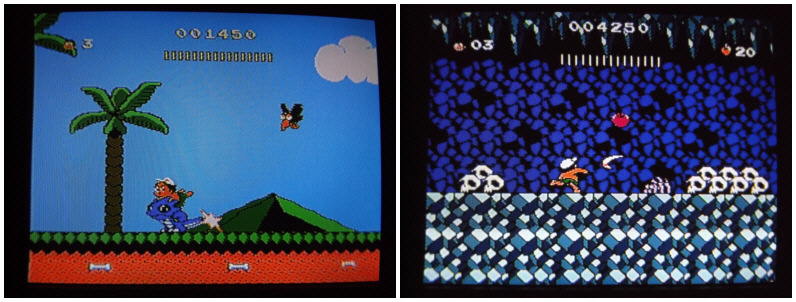
Hudson's Adventure Island
II and Hudson's Adventure Island 3
031. Adventure Island 2 - While game number thirty was Takahashi Meijin no Bouken Jima, the Japanese release of the game we know on the NES as Hudson's Adventure Island, the second game in the series included here is the North American release. While the first title was a light rework of Wonder Boy, Hudson's Adventure Island II took the original concept of a platformer based around speed and jumping accuracy and made it more console friendly. This really was the game that began to completely form what comes to mind when one thinks of an Adventure Island game, completely free of its arcade roots and able to be entirely its own game. While Master Higgins’ vitality is still constantly decreasing even while standing still (running in place actually) and collecting fruit is required to stay alive, the inclusion of this mechanic in the second game feels far less like an irritating way to increase difficulty. Grabbing fruit and keeping Higgins’ vitality up is still important but it isn't used as a "gotcha" to the severe degree it often was in the first Adventure Island. While the tropical setting is retained the art style gains a big upgrade over the previous game, which is expected as this game was released five years after the Japanese release of the previous title. By 1991 a lot had changed on the Famicom / NES, as well as in the world of video games in general, and Adventure Island II perfectly walks the line between what gamers expected of the era and what gamers expected of an Adventure Island sequel.
Visuals are bright and detailed yet cartoony and colorful. The music and sound effects also have been given a significant upgrade and while they are in the style of the previous game, they sound much more polished and diverse. The greatest enhancement comes in the form of play control as the drifty and overly floaty momentum of Higgins has been reeled in to a much more manageable level. Movement feels super precise and it is now much easier to perform complex jumps and instant corrections to Higgins’ footwork. There is also a lot more leeway in terms of limited bi-directional and vertical scrolling, making the game feel less like a forward centric speed-based platformer and more like a hop and bob action game. Higgins’ can't walk all the way back to the beginning of an area or have full free movement but the player has much more freedom to explore when in areas with multiple paths and platforms. For the most part this eliminates the problem of scrolling the screen just a little to far past an item egg, present in the first game, and makes it a lot more forgiving and enjoyable. The biggest gameplay change comes in the addition of four types of dinosaur friends that Higgins can ride. In addition to the expected stone axes or skateboards found in eggs, collecting a playing card suit icon will summon one of the four dinosaurs: two running dinosaurs - one that breathes fire and another that attacks with its tail, a flying dinosaur that allows Higgins to attack from above, and a swimming dinosaur that allows Higgins faster movement in the newly added underwater stages.
The release of Super Mario Bros. 3 in 1988 had a massive influence on platforming games and although it didn't invent many of the features it combined, the impact of its total package on game design as a whole is undeniable. I think no other series was more influenced by Super Mario Bros. 3 than Adventure Island. It now features individual area maps, an inventory where dinosaur friends and stone axes can be stored for later use, multiple islands to conquer that can be warped between by finding hidden keys, and boss locations that are clearly shown on each island map as the eventual objective. In a nod to the airships of Super Mario Bros. 3, if Higgins is defeated by a boss it will move to a previously completed area, requiring Higgins to backtrack and give chase, after completing the area where the boss originally resided. This game is an absolute classic of the platform and is far more accessible than the original, blending the classic and modern of the hardware perfectly. It's kind of like the Mega Man II of the Adventure Island series and my favorite of Master Higgins adventures.
032. Adventure Island 3 - Released only a year after Adventure Island II, Hudson's Adventure Island 3 is much closer to the design rules laid down by the second game rather than the first. Due to that it's much less of an upgrade than the previous game and more of a refinement. This time Master Higgins is after a UFO that abducted his beloved Tina and will pursue the alien invaders across the land. Weapons other than the stone axe return, this time in the form of the boomerang, which would go on to become an Adventure Island staple. Higgins can also now crouch down and move on his stomach, allowing for a lower attack arc than standing or jumping. An additional green dinosaur friend can be found who has a rolling attack and the new additions mean that Higgins’ inventory is even larger. New bonus areas feature the introduction of a surfboard, which would return in the Japan-only fourth Famicom Adventure Island game.
While Adventure Island 3 is built upon the assets of the previous game, the graphics look somewhat muddy and not as clean and the music is so similar it may as well be an exact lift. Due to the similarities with Adventure Island II one would assume the new features would be in addition to the game that came before but strangely this is not the case. The bosses no longer move around to other stages if they defeat Higgins and instead remain stationary at the end of their specific stages. The limited reverse scrolling has been completely removed and not permitting Higgins to take a step backwards in the game, makes for a huge step backwards in gameplay as far as I'm concerned. In some ways the whole game feels like a step back and more in line with the rigidity of the first game in the series, which limits its appeal compared to Adventure Island II. Rather than a new forward-looking game, the whole thing feels like some kind of middle ground between the first two games, a tremendous disappointment.
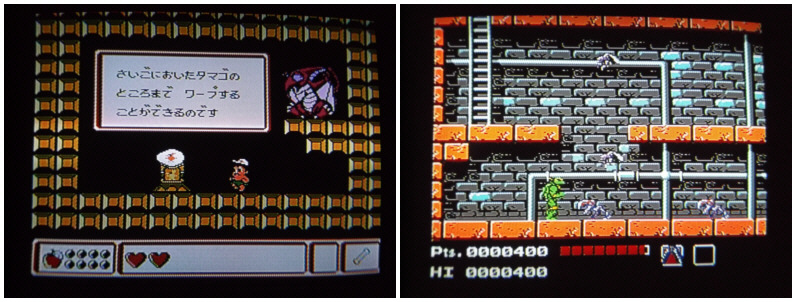
Takahashi Meijin no Bouken
Jima IV and Gekikame Ninja Den
033. Adventure Island 4 - One of the greatest games we missed out on outside of Japan! Takahashi Meijin no Bouken Jima IV (Master Takahashi's Adventure Island IV) takes the series in a different direction, more in line with where the Wonder Boy series went after the original game. Rather than being based around speed and jumping accuracy, Takahashi Meijin is now in an open and expansive world with characters to meet, items to find, minigames to play, and of course enemies to defeat. The Eggplant Wizard (no, not that one) has kidnapped Takahashi's dinosaur friends, so he leaves his lovely Tina at their hut and sets off to rescue them. As the dinosaurs have been captured, they don't factor in to the gameplay this time around. Instead Takahashi has a massive inventory and an assortment of weapons and items that would make Link green-er with envy. The stone axe has been traded in for throwable bones but they work in much the same way. Takahashi obtains a hammer early on but it serves more as a way to open paths than as weapon and is also used for a whack-a-mole inspired minigame. A torch to light your way in dark areas, a water gun to douse fires and grow vines, an umbrella to slow falling speed, a vast assortment of different weapons, health recovery items and more. Takahashi can also board over land, sea and snow with his trusty skateboard, Adventure Island 3's surfboard, and the new snowboard. A really cool item is the teleportation egg, which allows warping throughout the game. Once the teleportation egg is placed on a pedestal it can be warped back to by selecting the egg from Takahashi's inventory.
It plays like a standard action platform game, similar to Kriby's Adventure, and actually reminds me a lot of Rygar if it had a much smoother and less repetitive design. The entire game is beautifully designed and has more of an Adventure Island II feel in terms of colors and detail. Takahashi controls wonderfully and although he has his signature momentum that makes him a little slippery when running, it's a consistent and expected momentum that doesn't feel out of place. His duck and crawl move from Adventure Island 3 returns and is even more useful considering the variety of enemies and challenges he will face. Fruit is still present and has an affect on vitality but not in the same way as the previous games. Takahashi has a life bar represented by hearts with each hit draining one. He begins with two hearts, so he can withstand a single hit before fainting and restarting the game back at his hut. To the left of the life bar is a fruit indicator and Takahashi will refill one heart for every eight pieces of fruit he collects. Additionally the amount of fruit currently held will influence his stamina when competing in the mini games, such as the pole climbing event. I've you've ever played this game and wondered why you can't climb up that pole to get the compass, that's the reason - go pick up six or so pieces of fruit and then try it again. The pole climbing game is actually an extremely important part of Adventure Island IV as it's how the inventory based recovery items are obtained. Consider it a shop where you have to win a competition rather than buy items.
As the game has a lot of items to obtain and areas to explore, a password system was finally implemented. At any time Takahashi may backtrack to his hut and climb into bed. As he sleeps, a password is displayed which will allow the player to resume the game in that state at a later time. While it may seem backtracking to the beginning of the game just to get a password is a huge hassle, there's special ticket item that allows instant travel back to the hut. The trick to the password system is to place the teleportation egg on a pedestal in a far off area, use the ticket to return home and get the password, then use the teleportation egg in the inventory to return to the pedestal where the egg was placed. The ticket item can be obtained again by challenging the pole climbing minigame, basically acting like gearing up before setting out in an RPG.
This was actually the final officially licensed game for the Famicom, being released in the middle of 1994. While it's not the most technically impressive Famicom game one may ever see, it is truly well designed from start to finish and a game that should be played by everyone who enjoys platforming games. It truly feels like a labor of love, a proper Famicom send off to a game series that further cemented Toshiyuki Takahashi as the idol of Japanese video gaming youth and of Famicom culture in general. Although the game has Japanese dialogue and a fan translation patch was released way back in 1998, the game can still be completely played and enjoyed in its native language. Takahashi Meijin no Bouken Jima IV is another one of those overlooked crown jewels of the Famicom library - not mind-blowing but massively enjoyable and a completely entertaining total package. I'm glad the Famicom library ended with Master Takahashi.
034. Ninja Turtles 1 - Teenage Mutant Ninja Turtles was a fairly strange video game adaptation of the comic, cartoon and film media craze. Although the game's plot has some similarities to an episode of the cartoon series, the enemies and music have little to do with anything that came before or since. The Japanese version, Gekikame Ninja Den, is the one included on the cartridge. Outside of Japanese text, the core gameplay of the Japanese version is the same as the NES release, however the Japanese game rewrites April O'Neil as Splinter's daughter. Unsurprisingly this change wouldn't be carried over beyond this specific release of this specific game. As for the game itself, it primarily plays like a platforming action game with the gimmick of being able to switch among the four titular heroes in a half shell, each with their own health meter, primary weapon of varying power and speed, and secondary weapon ammunition stock. Action scenes are traveled between in an overhead perspective. These work a little differently than the map screens of other games as enemies roam the environments and must either be avoided or dispatched by the current turtle's weapon, or in the case of one stage, a missile or gunshot from the Party Wagon / Turtle Van. In addition to the action platforming stages there is the rather notorious area in the Hudson River where the turtles have a strict time limit to defuse a series of explosives. Contrary to what popular media may lead you to believe, this area is relatively simple and easy to complete compared to the frustrations later in the game.
That really is the biggest problem I've had with this game since I was a kid, the level of frustration and punishment enacted upon the player for small mistakes. Enemies are brutally overpowered, especially in areas four and five, and take way too many hits to destroy. Although a defeated (or captured as the game puts it) turtle can be recovered a couple times throughout the game, the whole thing must be completed in one shot. Although on paper the game isn't very long, the ridiculously unforgiving difficulty of the later areas makes for a game that many played but few completed. As a kid I would generally get up through area three and then turn the game off and play something else. Thinking back it was pretty crazy that among all my friends we really never played more than half this game, yet played that first half over and over. While this game sold spectacularly and the game itself is far from terrible, the name on the box is what equated to sales, not the quality of the game itself. The music is outstanding however, the one great achievement of this title, even if it has nothing to do with any other part of the Turtles franchise.
One thing of note with the version of the game included on the multicart is that it has a level select cheat built in. On the title screen, pressing the Select button once fewer than the number of the desired starting area before pressing Start as usual, will begin the game at that area. This alleviates one of my biggest gripes with the game - the inability to continue or have a password option. If the retail release shipped with this cheat built in or had a simple password option, I believe it would be far better remembered.
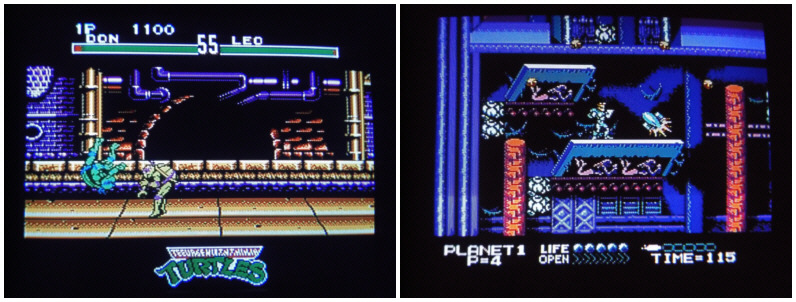
Teenage Mutant Ninja
Turtles: Tournament Fighters and Street Fighter 2010: The Final Fight
035. Ninja Turtles 4 - The next Turtles game on the NES would be a home conversion of the original arcade game with a couple extra stages, followed by a third game of very similar design. In the middle of the fighting game frenzy, a Turtles fighting game was released for the Super Nintendo and Sega Genesis with both versions having different character rosters and game mechanics. A year later a third version was released for the NES and Teenage Mutant Ninja Turtles: Tournament Fighters was the last game Konami released for the platform outside of Japan. While the Super Nintendo version of Tournament Fighters is one of the greatest and most underrated console fighting games of its generation, the NES release really isn't that hot in my opinion. Everything looks really good and controls are tight and well implemented with a turbo mode that gives the game good flow, but I simply don't find it very appealing or enjoyable. It's more fun to play than the Genesis release of Tournament Fighters but there simply isn't enough variety here to hold my attention, as it boils down to an extremely simplistic fighting game experience, with too much back and forth for my taste. It should be noted that some other Famicom multicarts that include this game feature a version that is massively cut down and missing nearly all story and cutscene content outside of the core game itself. The version included on the CoolBoy 198 in 1 is the full complete game as it shipped at retail.
036. Street Fighter 201 - The science fiction themed spin-off of the Street Fighter series, Street Fighter 2010: The Final Fight is one of those games that seemed to be without an audience from the beginning. The Famicom version centers on Kevin, a cyborg police officer tasked with bringing down the Parasites - a gang of super criminals with augmented powers due to their bodies serving as hosts for parasitic insects. This made the game a one-off standalone story in the Street Fighter series. However for the English localization Kevin was renamed Ken and rewritten to be Ken Masters of Street Fighter fame. As the story of the NES version goes, Ken has long since retired as champion of the Street Fighter competition and become a gifted scientist. He develops a formulation known as cyboplasm that allows any living organism to obtain superhuman strength. When the cyboplasm is stolen and his lab assistant murdered, Ken augments his body with bionic implants and sets off to recover the stolen cyboplasm.
If the story sounds ridiculous it's nothing compared to how the game actually plays. Imagine if Ninja Gaiden was reworked into a fighting game, still filled with platforms and infinitely respawning enemies, except the stages would have more open vertical real estate and the boss would be floating around somewhere in the stage the entire time. While defeating the boss is the primary objective, another requirement is to generate enough energy to open the portal to the next stage, sometimes requiring the defeat of more than a single boss. While it doesn't look or sound terrible the game is absurdly difficult due to the limited controls and the fact that enemies can come from pretty much any direction. It's like an entire game filled with Red Arremers from Ghosts ‘n Goblins. This is absolutely one of Capcom's weaker games, lacking anything resembling a solid foundation to build a game upon.
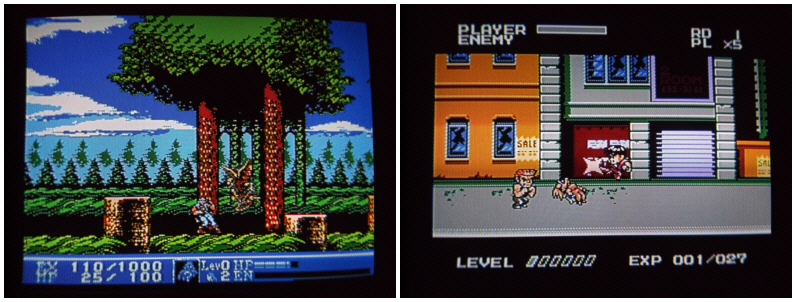
Kick Master and Mighty
Final Fight
037. Kick Master - The most affordable of the late release Taito published NES games, Kick Master plays a lot like Castlevania without a whip. Rather than a famed vampire hunter, the game's protagonist Thonolan is a martial artist, known for amazingly powerful kicking skills. Followers of the wicked Belzed have burned the kingdom of Lowrel, killed the king and queen, and kidnapped Princess Silphee. All of the king's guards were killed with the exception of Thonolan's brother Macren, a knight of the kingdom. As you and your brother set off to rescue the princess, Macren is mortally wounded and with his dying breath persuades Thonolan to avenge him and save Princess Silphee. That's right, the "powerful knight Macren" gets taken out by the very first enemy he encounters.
Kick Master is one of the most beautifully detailed and designed games to ever grace the hardware with vibrant and colorful graphics that make the game look more like a PC Engine / TurboGrafx-16 release. The sound design is pretty incredible as well, climbing to the echelons of the best that Konami, Capcom or Tecmo published on the NES. When enemies are defeated they burst into three items, randomly chosen, that can either power Thonolan up or down. Collecting shield icons of varying sizes grant experience points that not only increase Thonolan's life bar but also add to his kicking arsenal. Potion icons recover magic points, used for the large variety of spells that Thonolan will learn throughout the game. Spells take the form of offensive secondary attacks, defensive protections, and extremely important life recovery. As mentioned it's not all enhancements from defeated enemies, as mixed in with the powerups are skull and crossbones icons, which drain Thonolan's life as if running into an enemy.
If you have never experienced Kick Master, this would be my pick of the fifteen games this time as the one to play. It is an enjoyably challenging and well-crafted action platforming game with some of the most impressive game design seen on the NES. A true hidden gem if there ever was one. Unfortunately Kick Master was only released on the NES and never appeared outside of North America likely due to the shuffling around of publisher Taxan, of which Kick Master developer KID had publishing ties with in the past. Taxan was and is a subsidiary of Kaga Electronics, whose later internal video game division was the legendary Naxat Soft, taken from "Taxan" spelled backwards. Naxat was renamed Kaga Create Co., Ltd. in 2007 before shutting down in 2015. Taxan on the other hand still exists, however they are probably better known for manufacturing projectors for the American market these days as the USA branch of Kaga Electronics.
038. Mighty Final Fight - Another fairly expensive and hard to come by game, Mighty Final Fight takes the hugely influential arcade beat ‘em up Final Fight and shrinks everything down to a super-deformed mini size. A comical retelling of the events of the first Final Fight game, almost to the point of being a parody of it, what we have here is one of the finest 8 bit beat ‘em up games. Although the game is a single player only affair, it contains all three of the Final Fight regulars - Cody, Guy, and Mike Haggar, along with their recognizable moves and different fighting styles. Similar to the NES conversion of Double Dragon, Mighty Final Fight utilizes a leveling system with experience points gained by defeating enemies. If a stronger finishing move is used more points are given, creating a real strategy to the otherwise repetitive brawling action. Each level gain is accompanied by an increase in attack power and maximum health. Additionally once reaching level four each character gains a specific additional special attack.
While it might not be the deepest or most detailed beat ‘em up, Mighty Final Fight delivers in the most important department: it's simply a ton of fun to play and extremely satisfying. Beat ‘em ups on home consoles have always had the disadvantage of the design DNA of the genre, that is repetition to coax more and more quarters out of players at the arcade. The leveling system introduced in the NES conversion of Double Dragon was an attempt to make the home version something more, with an extra layer of strategy. Mighty Final Fight is the one game that takes that concept and polishes it to a fine shine, using the leveling system to increase power and stamina while not punishing players by using it to limit the move assortment. As the only exception is the fourth level threshold granting the additional special attack, it feels more like a reward rather than a chore. Controls are tight and accurate, with a silky smooth frame rate and nicely detailed reworks of the franchise's characters. It feels like one of those great fighting game conversions on the NeoGeo Pocket Color, except this time for a beat ‘em up. The dialogue changes to make the game more comedic also go the extra step to make this a unique and entertaining experience, even for a Final Fight regular.
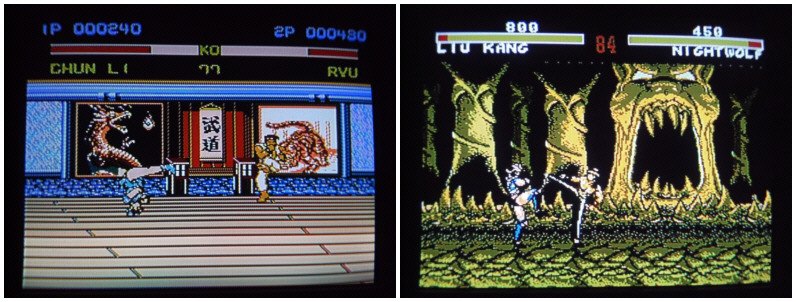
Street Fighter 12 Peoples
and Mortal Kombat 4
039. Street Fighter - We finally strike another pirate original with Street Fighter 12 Peoples, a game that has a long history as a Taiwanese developed pirate conversion of Street Fighter II: Championship Edition, originally titled Street Fighter II Pro. Originally developed by Cony Soft / Yoko Soft, a company primarily known as a developer of pirated fighting games, the original 1993 release of Street Fighter II Pro was more or less a Famicom version of Capcom's Street Fighter II, featuring the eight original characters. As a bootleg Street Fighter II was considered a hot commodity, it was further hacked and pirated to death with a vast assortment of different versions.
Let's see if I can keep the path from the original Street Fighter II Pro to the game included on this cartridge, Street Fighter 12 Peoples, straight without losing anyone:
Developed by Cony Soft, 1993’s Street Fighter II Pro featured the original eight Street Fighter II characters and stages and presentation similar to genuine Street Fighter II. This was essentially a brutally difficult vanilla bootleg of Street Fighter II for the Famicom.
1993’s Street Fighter IV Pro 10 added Balrog and Vega to the original Street Fighter II Pro game to create a larger roster of ten fighters. In the chain to Street Fighter 12 Peoples, this is the last game that known to be directly developed by Cony Soft.
1993’s Street Fighter V (20 Peoples) uses the fighter roster from Street Fighter IV Pro 10 but reworks the stage backgrounds and some of the player icons. The new stage background assets would be used again later.
1993’s Street Fighter IV (8 Peoples) uses only the eight original fighters yet borrows other assets from Street Fighter V (20 Peoples) but removes stage background scrolling, possibly due to a programming glitch. This would be carried over to subsequent games derived from this title.
1993’s Street Fighter IV (16 Peoples) is derived from Street Fighter IV (8 Peoples) although every character has a duplicate to double the roster, making for the titular 16 characters.
1996’s Street Fighter IV (12 Peoples) removed Dhalsim and Zangief from the roster of Street Fighter IV (16 Peoples) but is otherwise the same. This means the game's roster is comprised of six fighters, each duplicated to make the titular 12 characters. This is the game included on the 198 in 1 cartridge.
All that said how does it play? Not that well to be very honest. Single player is a complete exercise in frustration as the computer opponents are insanely difficult as they will constantly use special moves. Included fighters are Ryu, E. Honda, Blanka, Guile, Ken, and Chun Li. While the graphics aren't bad they are a heavily flickering mess and the game has a weird tendency to speed up and slow down at unexpected times, causing characters to slide around the screen strangely and interfere with control inputs. When the game is cooperating, special moves respond as they should and are fairly easy to pull off. If there is one thing I do like about this game it's the music as features some solid, yet not spectacular, renditions of the familiar Street Fighter II tunes. Playing against a friend, a few moments of fun can be had here as a stupid diversion but this version of this game simply removes too much of the familiarity that the very earliest releases had.
040. Mortal Combat 4 - Here we go again. I suppose one bootleg fighting game deserves another. Is this divine punishment for disliking Teenage Mutant Ninja Turtles: Tournament Fighters? Mortal Kombat 4 is actually a hack of a pirate version of Mortal Kombat 3 originally developed by Taiwanese company Hummer Team. The included version is actually the most cut down of all releases with a tiny character roster, a character select screen that often doesn't match up to the character selected, and only three different stages. Some versions of this game are decent for a bootleg fighter but the one included here is a total waste and not even worth checking out as a curiosity, as there's just so little to it.
Huge thanks to the "BootlegGames Wiki" for assistance on making some sense of these pirated fighting games!
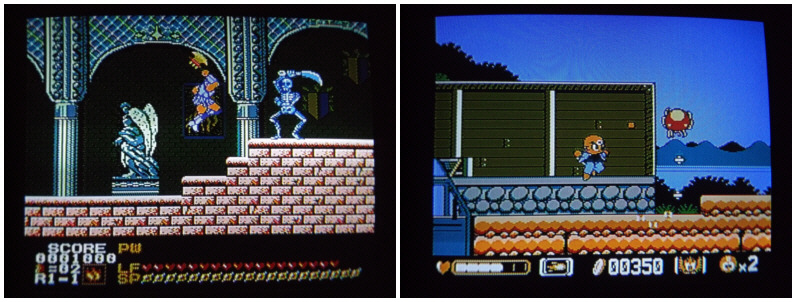
Astyanax and Mitsume
ga Tooru
041. Astyanax - The Legendary Axe is often considered one of the greatest early releases on the TurboGrafx-16 and by thought by some, including myself, that it should have been the pack-in game launched with the system in the United States. That game was designed by Tokuhiro Takemori and one year later he would design a very similar arcade game called Lord of King in Japan and The Astyanax in the USA. An expanded home version for the Famicom would also be developed one year later it was localized for release on the NES, simply titled Astyanax. The home release features a rather extensive story told though cutscenes similar to the Ninja Gaiden games. This time around Astyanax is the name of a sixteen year-old high school student who is having reoccurring dreams about hearing a woman's voice calling out to him. On his way to school he is suddenly teleported to the kingdom of Remlia by a fairy named Cuite. She has summoned him to rescue Princess Rosebud, ruler of the land, and will serve as his guide on his adventure to defeat the evil wizard Blackthorn.
This is a great, albeit very difficult, action platform game that reuses the unique attacking system first utilized in The Legendary Axe. Astyanax has a power gauge that is constantly refilling to its highest available level. Each time he swings his weapon, the power gauge drains before filling back up again. Attacking before the power gauge fills up completely will strike with lower power. This means that rapid attacks come at the price of weaker results. It's a system that puts a lot of emphasis on making accurate attacks, as while Astyanax can always rebound with quick slashes, they will be far less powerful than a well-placed full power strike the first time. The power bar can be expanded by collecting items hidden in statues, with a longer power bar providing stronger attacks at the compromise of requiring more charge time between strikes. The sprites are huge for an NES game and are very detailed and colorful. However the detail comes with a price and that is a healthy amount of slowdown during the more heated moments, with the entire game sputtering along and just trying to keep running at an acceptable speed. In an expansion over the gameplay of The Legendary Axe, Astyanax can use three different offensive magic spells. Although he begins the game armed with an axe it can be upgraded twice, first to the weaker spear and then to the more powerful sword. For a game that opens with such a fantastical introduction, Astyanax's story takes itself surprisingly seriously for an NES game, with a long and somewhat mature narrative that culminates in one of the most satisfying ending sequences of any NES title. While not the most spectacular game one may play, this is an overlooked title that is definitely worth spending some time with.
042. Three Eyes Boy - Although it sounds like an odd title, it's actually a fairly literal translation of Mitsume ga Tooru (The Three-eyed One), a Famicom only action platform game. It is based on a manga series by the legendary "father of manga" Osamu Tezuka that ran from 1974 to 1978. An animated television adaptation aired between 1990 and 1991 and as was normal at the time, a game for the Famicom followed shortly thereafter. The player controls Hosuke Sharaku, last survivor of the three-eyed tribe and recipient of psychic powers. He's off to rescue his friend Wato Chiyoko from the crazed Prince Godaru, his ancestor. Hosuke attacks enemies by shooting energy out of his third eye and can also summon the Red Condor, which functions both as a floating weapon as well as a jumping platform to reach higher areas. Defeated enemies drop coins that can be spent in shops on different types of psychic shots, health refills, extra lives and more. While not the most incredible game, Mitsume ga Tooru avoids a lot of the pitfalls generally encountered with a licensed title. Natsume did a solid job adapting the source material into a game that is still enjoyable without any knowledge of the manga or anime it is based upon. The game is rather short and not all that difficult but it's very well designed with bright and colorful visuals and outstanding gameplay. Well worth a try and easy to figure out even though all the text is in Japanese. A fan translation was released in 1998 for those who wish to play Mitsume ga Tooru in English.
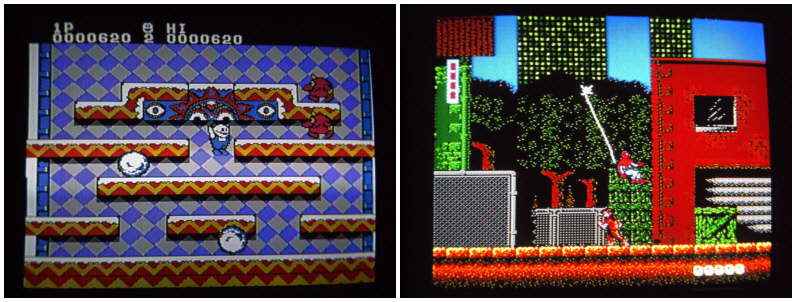
Snow Bros. and Spider-Man:
Return of the Sinister Six
043. Snow Bros. - Yet another game that has become ridiculously expensive in recent years. Well, I take that back, it was always one of the more expensive games - it just grew exponentially along with the other harder to find titles. Snow Bros. is a home conversion of Toaplan's 1990 arcade game that plays a lot like Taito's Bubble Bobble with some modifications. Nick and Tom are a pair of snowmen who throw snow at their enemies, covering them up and rolling them into snowballs. Once an enemy is completely encapsulated in snow, it can be rolled and knocked off platforms, rebounding as it rolls downward, smashing other enemies along the way. Once the snowball reaches a wall it cannot rebound against it will shatter, defeating the enemy contained within. On occasion an enemy will drop a potion granting a movement speed increase, snow throwing speed increase, snow throwing distance increase, or temporary invincibility. After every ten stages the Snow Bros. will be confronted by a large boss, which adds in some variety. Snow Bros. on the NES looks and plays great and is an excellent home conversion of the arcade original. It may not have the color depth of the arcade version but it is just as fun, especially with a second player. Not $300 fun, but a very nice addition to this multicart.
044. Spiderman - Of the forty-three games on the cartridge that came before this one, as bad as some of them may be, they have all had some degree of merit. Some are flawed, difficult, poorly designed - sure, but they all have had something redeeming about them. Even Mortal Kombat 4 from this issue at least began as a decent bootleg version of Mortal Kombat 3 before being cut down for inclusion on the multicart. Spider-Man: Return of the Sinister Six is by far the worst game we have yet to encounter on the CoolBoy 198 in 1, and the version included is actually missing some things over the retail release. All of the text describing the game plot has been removed as well as the illustrations that accompany the introduction to each stage. However instead of patching out the removed graphics in the program code, the game sits at a black screen, waiting for the player to fumble around with the controller and advance the game. Hilariously the first thing displayed when the game is turned on is "Spiderman start the adventure and save the world."
Some people love this terrible game, consider it above average and if anything a decent action title. If you're one of those people, well then, good for you. For everyone else this game is an underdeveloped mess with tiny muddy graphics, infuriating controls, and some of the flat out worst hit detection of any game released on the console. This is one of those NES games that looks like it was someone's first attempt to learn basic implementation of the hardware. As in just getting some graphics that sort of look like Spider-Man up on the screen and being able to generally manipulate him with the controller. However instead of improving anything, it's as if the developer B.I.T.S., Ltd. decided to continue forward and build the entire game off what looks and feels like a first development pass. Spidey can barely jump over obstacles and has a completely useless wall climb that serves as a showcase for how haphazard the background object detection is. It's one of those "you can go here but not there, you can stand on this but not that" games with no clear logic of what the game will or will not allow you to do. Web slinging and swinging never feels natural and it's difficult to get into a swinging rhythm due to the odd control choices and arbitrary background detection for web attachment. Attempting to attack enemies often results in Spider-Man punching, kicking or sliding right through them and taking damage. This means the key to getting anywhere in the game is to avoid enemies at all costs, which is kind of counterintuitive to a game featuring a superhero. The entire package looks, sounds and plays like it was some filler title on a fly-by-night company's multicart, so I suppose it's fitting that it is included here. Shame on you B.I.T.S., Ltd. and shame on you too LJN for putting this barely functioning smoldering pile on the market and coning kids out of their money. I am absolutely dumbfounded as to why this game is given high ratings and accolades, even at the time of its release.
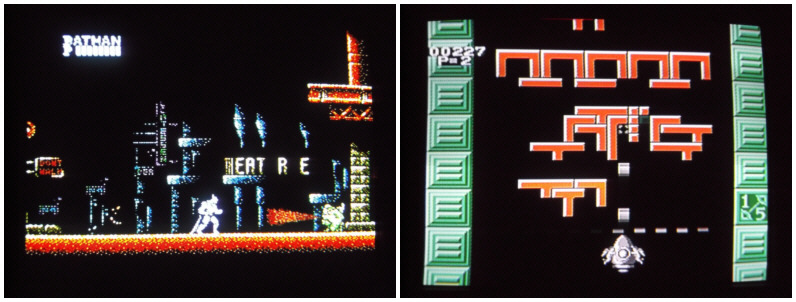
Batman and Quarth
045. Batman - Widely considered one of the greatest superhero video games of all time, Sunsoft's Batman blew everyone away with its spectacular presentation and focused, challenging gameplay. Loosely based on the 1989 feature film, Batman takes creative liberties where necessary to avoid the traps commonly associated with games based on movies. Taking a page out of Ninja Gaiden, Batman has smooth agility and wall jumping abilities that are a bit like a middle ground between Ryu Hayabusa and Strider Hiryu. While Batman cannot scale walls directly, his grab and turn maneuver is extremely predictable and controllable, allowing complex movements to be accomplished with relative ease. The level design often exploits this control feature, occasionally to an insane degree, and mastery of Batman's movement becomes a requirement early on. This is how to do a superhero game to near perfection.
In addition to using his fists, Batman comes equipped with three projectile weapons: his signature batarang, a spear gun that has greater power and range, and a dirk that splits into three to cover a wider area. The more powerful the weapon, the more bullets they drain from the same common pool. These can be replenished by picking up the bullet icon occasionally dropped by defeated enemies. Although the controls are perfectly implemented and the game has cleverly designed levels, the challenge here borders on absurd, especially during the final battle with the Joker. I have noticed an interesting and potentially crippling glitch with this game on the multicart. Normally when Batman is out of weapon ammunition he automatically returns to punching after a very short delay. However on the multicart when Batman runs out of ammunition he is stuck holding the last selected weapon, except he has no ammunition to fire. As he is in a weapon mode, he is unable to punch and becomes completely defenseless. Of course making sure not to drain the weapon ammunition tank completely would step around this problem, but it's something to keep in mind if you plan on playing Batman on the 198 in 1 cartridge. I have also found this game noted as the USA prototype of Batman in some lists online but this is not the case with my cartridge. Perhaps the older 198 in 1 cartridge used the prototype but the game included here is the standard retail release with the exception of the above mentioned weapon glitch.
CoolBoy 400 in 1 Real Game, Spotlight Selection:
067. Quarth - There aren't a whole lot of games considered to be "puzzle shooters" but two of my favorite puzzle games happen to fall into this small genre: Palamedes and Quarth. I previously covered the Famicom version of Quarth in the forerunner to The Retrogaming Times, Retrogaming Times Monthly - issue #106 in March of 2013. That was a detailed comparison between the American arcade rework titled as Block Hole, the original Japanese arcade release as Quarth, and the Famicom home conversion. Quarth is a little bit like a combination of Tetris and Space Invaders, with the enemy in Quarth taking the form of a mass of geometric blocks, indestructible through common means. In order to defend the planet a special ship is launched, guided by angels, with the power to destroy the incoming objects. By using the ship's cannon, the invading blocks can be grown to form squares or rectangles, making them self-destruct. A completed square or rectangle will spiral off into smaller blocks, awarding points as it is eliminated. Your ship is always advancing forward, pausing only briefly when a block is being counted off the play area. Making larger squares or rectangles from multiple blocks will eliminate any in the group, including blank spaces, and award bonus points in addition to stalling your ship's forward movement for longer. The Famicom version reworks the arcade play style slightly, adding in power up blocks to mix things up a little.
I talk a lot about hidden gems and forgotten games on the NES and Famicom but Quarth is the real deal in this respect. It has continued to receive releases in Japan and Europe on mobile phones, compilation releases, and even in other games as a minigame but there really hasn't been an enhanced version for quite some time. It's too bad that more people in the USA aren't familiar with the title outside of the Game Boy release. Efficiency in the game is rewarded, incorrect shots can be remedied with fast action, and careful planning must be balanced with spontaneous reaction. Quarth succeeds as a puzzle shooter because of how flexible it can be within a specific set of rules.
Next time we'll pick up the list with game
046 on the 198 in 1 cartridge. The next fifteen games are a rather
mixed bag of titles from all over the Famicom and NES release history,
including Namco's first Famicom release, an action game everyone seems
to love but me, a few arcade conversions, and a later release Disney game.
At least there will be some variety, I suppose.
|
The next controller to explore and to me the most recognizable and perfect controller ever made: The Nintendo Entertainment System or NES controller. This is the controller I grew up on as a kid in the mid 1980's. Before the NES there were a few dull years of the home console business in the United States. The Atari 2600 fizzled out in the early 1980's and there needed to be a new and more advanced home console system created. A little company called Nintendo had the answer. The NES opened in the West to a huge success with games like Super Mario Bros., The Legend of Zelda and Mike Tyson's Punch-out; but for me it was the controller that caught my eye and made me want to play as many NES games as possible. In 2009 the NES was named the single greatest video game console in history by IGN.
What differed from the previous controllers was the control pad. In the past controllers had a bulky "joystick" or handles to move around the character or ship on the screen. Nintendo came up with the idea of a plus shaped flat pad for easy mobility. This was a great way to maneuver the action on the screen using just your thumb. Additionally there are red "A" and "B" buttons on the right side to act as the action buttons depending on the game you play. Of course, there are the "Select" and "Start" buttons in the middle that are generally used to modify options and begin the gameplay.
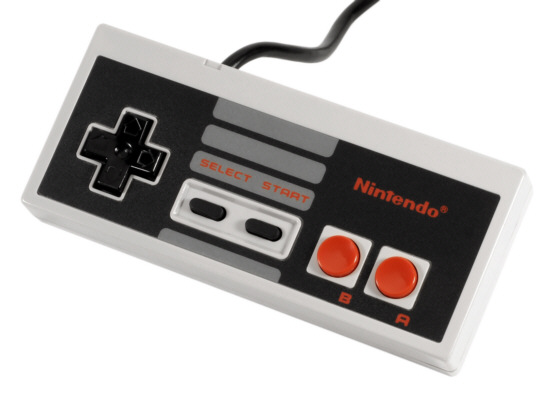
The classic Nintendo
Entertainment System controller
One of the first games I played, and to this date is my all-time favorite video game of all time, is The Legend of Zelda. This first chapter on the still popular franchise was essential to the evolution of gaming. The objective seemed simple yet was one the most challenging games the NES had produced. You would use the control pad to move around the character named Link. The A button would be the way to use Link's sword to attack the enemy. There were three different levels of swords depending on your level of play and if you found the hidden sword. The B button has many functions depending on the item you want to use. Items such as the magic flute, the bow and arrow, and the red or blue potion. The Legend of Zelda is a classic game that even today is fun to play with all ages.
Another memorable game with the NES controller is Track and Field. This game put the controller to the test of durability. If there is ever a game that could break the controller, it was Track and Field. The controls were different depending on the event you were participating in. For example, the running events would use A and B to run and the controller would be the jumping (hurdles, long jump, triple jump) or throwing (javelin, archery). The longer you hold down the control increases the angle of your throw or jump. Then there was skeet shooting which used all aspects of the pad. Left side shooting used the controller and the right side was used by the A button. It took a lot of hand eye coordination to master these events and continue to the next level. But then the pen cap happened. Before Twitter and Facebook there was word of mouth, and someone spread the word that you can use a pen cap on the A and B buttons to increase speed and agility in the game. This brought world records to a whole new level in the game. And after hours of cranking the pen cap across the controller, except for maybe some scratches and scuffs the pad always seems to work the next day.
Then, of course there is the most iconic video game code in history which uses the NES controller. The game created by Konami was first launched in the arcade in 1987 and then created for the Nintendo Entertainment System in 1988. We all know the name and the code. Contra is one of the most popular old school games in the public eye and the code is recited by people of all ages. UP, UP, DOWN, DOWN, LEFT, RIGHT, LEFT, RIGHT, B, A, START! This classic code will give the player 30 lives to begin the game. Little known fact is the code was originally used for the NES game Gradius in 1986, but will always be linked to Contra.

Contra, The Legend of
Zelda, Track & Field
The NES controller has had many third party variations over the years and some enhancements to it as every controller has, but the original NES pad is still the most popular and groundbreaking in my opinion. There is also the NES PowerPad, NES Advantage, NES Zapper light gun (Duck Hunt) and R.O.B. the Robot. These additions made gameplay more exciting to the gamer. Most games in the NES library still are better using the original controller that came with the system.
Coming in November 2016 is the Miniature NES, which will have 30 pre-loaded games on it. The included NES controller will look similar to the original but will also be able to connect to a Wii Remote so you can use the classic controller to play on Virtual Console.
Next issue we will explore one of the most
underrated consoles of all time, The Sega Dreamcast. We will explore
the Dreamcast controller and how it changed the way people play games,
which included the ahead of its time VMU (Visual Memory Unit).
|
In 1996 arcades in the United States were still doing pretty well. While the boom time of the early to mid 1980’s had long since passed, the adaptation of the JAMMA arcade standard meant that operators coQuld easily and economically keep a fresh variety of games running in their arcades. The fighting game explosion was still in full swing, nearly completely overtaking the beat 'em up frenzy that had come before it. Sega had released Daytona USA a couple years prior and the game was continuing to spread like wildfire, already cementing itself as the absolute king of arcade driving games. I can't think of a single medium-sized arcade in the area that didn't have at least four Daytona USA seats, in fact quite a few had six while a couple others had the full complement of eight. Yet in the midst of all that, a small group of arcade game collectors came together to publicly exhibit and share their games past and present, creating a humble game show in the heart of Silicon Valley known as California Extreme.
Twenty years later California Extreme remains, far outliving the Bay Area arcades that were once its contemporaries. It's pretty crazy to think that this show has been running for twenty consecutive years. It really is one of the few long running arcade events I can think of that began back when arcades were still fairly active and popular, and has continued unwaveringly every year since. It's almost as crazy to think this was my ninth consecutive year in attendance. For those who have never heard of California Extreme, in a nutshell it's a massive gathering of arcade owners, collectors, hobbyists, and enthusiasts. A bunch of people haul their games to a central location and make them available to the public for play. A modest entry fee gets you in for the entire weekend (Saturday 11am to 2am Sunday morning, and then on Sunday from 11am to 9pm) and all games contained within the show are there to be played and are free to play outside of the entry fee. Additionally California Extreme hosts a full complement of panels featuring everything from industry reunions and presentations to trivia competitions and film screenings. There are multiple tournaments including a professional pinball competition, an old school Street Fighter Hyper Fighting tournament hosted show attendees, a prototype games tournament this year, and more. There are a dozen or so merchandise vendors exhibiting and selling products as well as a console gaming section with even more vendors and free to play games. Live music concerts also take place in the evenings, presented in partnership with Rockage: San Jose, who also hosts a local retrogaming and music festival. Once again California Extreme was hosted at the fabulous Hyatt Regency, Santa Clara.
Since this was the ninth show for me (many
of which I covered for Retrogaming Times Monthly, the forerunner to The
Retrogaming Times) I thought I would focus my report on a few of my favorite
arcade games that aren't seen very often and on some of the awesome live
music that was performed at the show. California Extreme is known
for having many prototype, rare, and rarely seen games on display right
along side the classics one would expect at an arcade show of this size.
Of the hundreds and hundreds of arcade games and pinball machines at the
show, these are a few that stand out to me and are games one generally
doesn't have the opportunity to play that frequently.
Great Swordsman - Taito, 1984
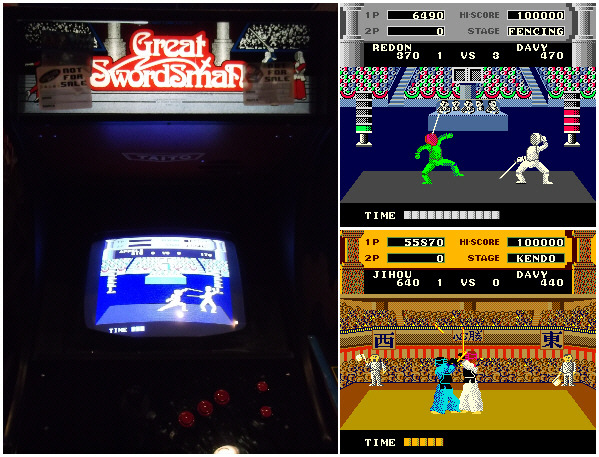
Although I'm sure many people are tired of hearing about it from me, Great Swordsman is one of the most unique, challenging, rewarding, and entertaining arcade games ever created. While a single player swordfighting game may not sound all that engaging at first mention, give this one a shot. Control consists of a left / right joystick and three buttons used to denote sword position low, middle or high. Duration of button press along with joystick motion will cause the player's character to perform different lunges and strikes, similar to Data East's Karate Champ, released in the same year. Three different disciplines of swordfighting are presented as the game's three main levels with multiple competitions within each. Sport fencing is first, with the goal to be the first to land five touches in each match against three different opponents. Next is kendo, with the goal to score two points in each match against five different opponents. Last is gladiatorial combat, with the goal to win a single strike battle to the death against seven different opponents. In between disciplines a bonus stage is presented where arrows must be deflected away with the sword to rack up big bonus points.
While the game looks very simple it can
be outrageously complex and tense. Although each match can be approached
with a specific strategy in mind, often times finesse and baiting your
opponent to give you an opening to strike are the keys to victory.
There's also a lot of hidden and varied stuff in the game, some of it with
a comical touch such as tagging your opponent in the rear or knocking their
fencing foil out of their hand, only to have it flip up and stick into
the top of their mask. If you have never played this game, give it
a try. However I would avoid the version included on the Taito Legends
compilation (PS2, Xbox, PC), as it feels very sluggish compared to the
original, at least to me.
I, Robot - Atari, 1984
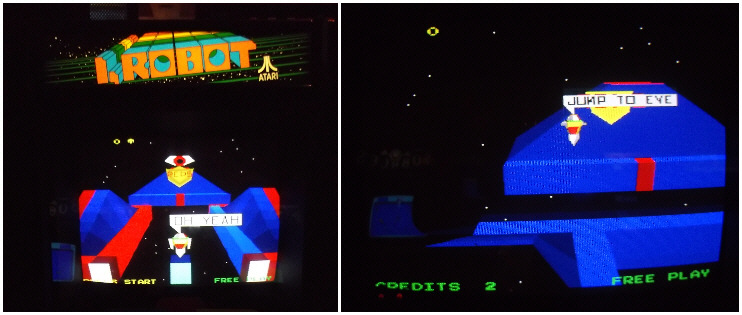
If there were a game I wish I had played earlier on in my life it would be Atari's I, Robot. This is both because it's a ton of fun and because the machines go for ridiculous amounts of money these days due to their rarity and obscurity. I, Robot is historically important as it was the first video game to use polygons as well as the first video game to allow the player to change the camera perspective on the fly. At its core, the main objective is to guide Unhappy Interface Robot #1984 to claim all the red colored territory in a stage. As territory is turned from red to blue by moving over it, the shield around the giant eye of Big Brother is reduced. Crossing gaps is achieved by simply holding the joystick in the direction of an adjacent platform, which will cause the Robot to jump. However if the Robot is in the air while Big Brother is watching, he will be destroyed with a laser shot. Hazards such as flying enemies and projectiles can be shot by the Robot using one of two fire buttons. The "Player One Start" and "Player Two Start" buttons move the camera's visual perspective up and down on the fly, affecting the score multiplier. The lower the perspective on the playing field, the more points that are scored however the lower angle reduces the player's field of vision and makes hazards more difficult to see. This is an ingenious risk / reward system that eventually becomes a critical game mechanic as there is a specific enemy that requires manipulation of the camera perspective to be avoided. Once the shield around Big Brother's eye has been disabled, the robot can jump to Big Brother and claim the last square of red territory, completing the level.
Once a level is completed the game becomes a 3D shooter where the Robot must destroy tetras, asteroids, and enemies before landing at the next stage. Variety is added in stages where mazes must be quickly navigated rather than territory claimed. Additionally after every few shooting stages the Robot must battle a flying head that fires spikes out of his mouth. Every spike must be destroyed to avoid losing a life and by shooting the head it will turn around and be unable to fire. Ever battle Andross in StarFox? It's kind of like that, only way more intense and way more detailed and fluid - and this was in 1984!
When the game was released it was unlike
anything else both visually and gameplay wise. Unfortunately this
meant it was met with massively underwhelming reception, leading to a very
small production run with many of the games that were produced converted
to other titles by operators. Honestly the game still feels unlike
anything else, which I think adds to its addictiveness. It was something
new then that still feels new today. That said I could understand
why it can be a hard game to get someone to try. I feel the key to
I, Robot is to watch it being played and then learn from someone who is
familiar with the game. The moment the controls and objective "click"
in your mind you will be addicted to the game for all time.
Crazy Climber - Nichibutsu, 1980
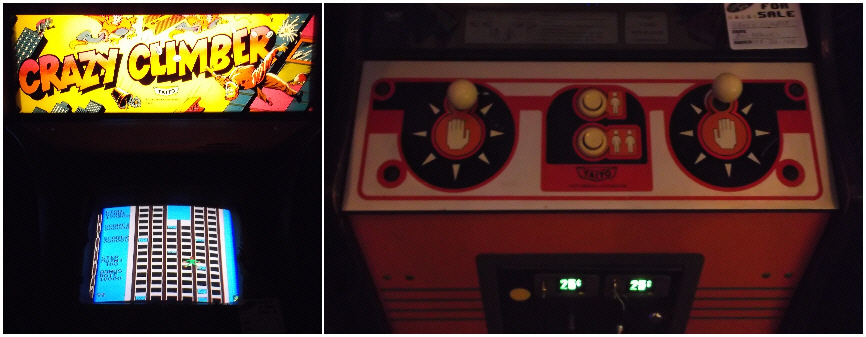
Surely inspired in part by George Willig scaling the World Trade Center's South Tower in 1977, Crazy Climber is all about a regular guy climbing up some very tall buildings - and all the crazy stuff he deals with along the way. Where on paper this may sound like a boring and rather simplistic game idea, Crazy Climber shines with a spectacular gimmick. Rather than control the climber with a single joystick or a couple of buttons, the climber is manipulated via a pair of joysticks. These joysticks control the placement and position of his hands, the left joystick for his left hand and the right joystick for his right hand. This not only gives the player much flexibility in how the buildings are scaled, it also makes the game an early full-body arcade experience. That might not make sense unless you've played the game but playing Crazy Climber is seldom done without twisting in place, moving your upper body alternately side to side, as if the player themselves is scaling floor after floor on their way to the top. It's hard not to let go of both joysticks in response when knocked off the building by poor hand placement, a falling obstacle or having a window slammed shut on the climber's hands. You'll also have to contend with King Kong, an egg laying and poop dispensing giant bird, electric signs with exposed wiring, and the complex architecture of the buildings themselves. Climb to the top, grab hold of the escape helicopter flying around above for bonus points, and head off to the next building - four building configurations in all.
Crazy Climber is considered by many to
be Nichibutsu's most well known game, at least outside of Japan.
Within Japan I would say they're more known for the F1 Circus series and
of course pioneering the "strip mahjong" video game in 1983, which they
turned into a very profitable game genre in it of itself. Crazy Climber
is another one of those games that it really has to "click" in the mind
of the player in terms of how the nuances of the control scheme work.
After some practice amazingly nimble and complex movement can be accomplished
with relative ease. I can think of no other game from this era where
the on screen character feels so directly connected to the player standing
at the cabinet and vice versa. The decision to use a unique control
method elevates this game from a simple concept to a flat out classic,
perhaps only eclipsed by its extremely rare Japan-only arcade sequel released
in 1988.
SegaSonic The Hedgehog - Sega, 1993
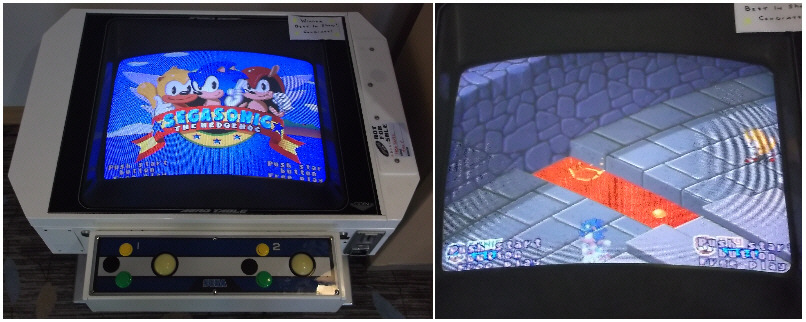
Easily the most obscure and lesser-known Sonic the Hedgehog game, and the only one to use a trackball for movement, SegaSonic The Hedgehog is a game I never expected to see in person. The game had an extremely limited release and was rarely seen even within Japan. The game can be configured to have two or three total players and features Sonic the Hedgehog, Mighty the Armadillo, and Ray the Flying Squirrel. Mighty would later appear in Knuckles Chaotix on the Sega 32X. Ray on the other hand only had one other appearance, as an unlockable key fob swinging from the rear-view mirror in the 1994 Japan-only Sega Saturn game Gale Racer, a haphazard conversion of the 1991 arcade game Rad Mobile. Coincidentally the original arcade release of Rad Mobile was the first appearance of Sonic the Hedgehog - as the key fob swinging from the rear-view mirror!
While the game is presented in an isometric perspective similar to the later Sonic 3D Blast games, the big difference between the two is the sense of speed and how the arcade game faithfully recreates the platforming elements of a Sonic game. A trackball is the perfect input device for a Sonic the Hedgehog game presented in this perspective, as it provides accurate pinpoint control and exploits fast rolling of the trackball to allow Sonic and his compatriots to move with the blue hedgehog's signature speed. There are also gimmicks in the game that perfectly utilize the control method, such as conveyor belts that must be run on at high speed to open gates. A single button is used to jump, and when used in combination with the trackball, perform a spin attack. It really does play like a classic Sonic game except in 3D. The levels are appropriately short and the obstacles varied enough that the whole thing works perfectly in an arcade setting, avoiding the feeling that it's simply "Sonic in an arcade cabinet." At California Extreme the game was housed in a beautiful two-player Sega Aero Table cocktail cabinet and it felt like the perfect way to experience the game. I took the opportunity to play though the entire game on Saturday evening and let me say, at least on a first play, this game is tough! Extremely challenging and addictive - it is a shame that it didn't have a wider release and isn't better known.
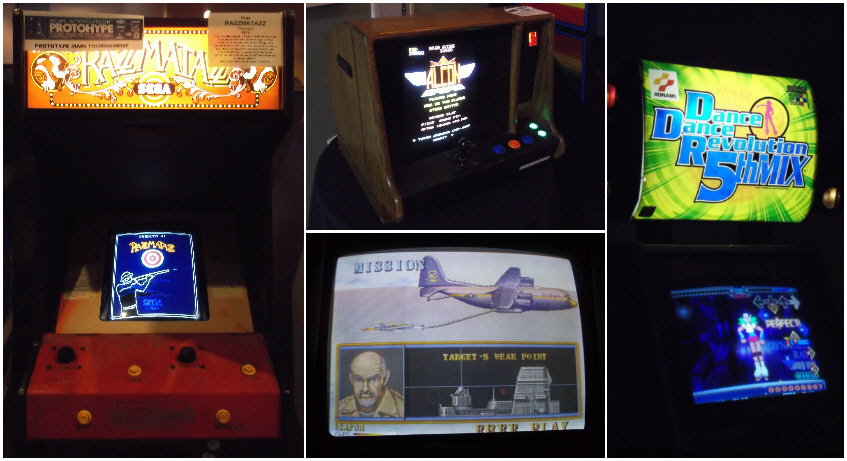
Quick mention of a few other titles before this runs into an encyclopedia of the games at the show. Tucked away in the corner of the convention floor was a little bartop cabinet running Toaplan's massively influential shooter ALCON, also known as Slap Fight. ALCON was more or less the game that the maniac genre of shooters was born from, with massive amounts of small choreographed enemy projectiles and gameplay that requires the player to dodge into the right places at the right times. It uses a powerup system similar to Gradius but is filled with compromises, such as weapon increases that make your ship a bigger target and speed powerups that still don't enable you to outrun enemy shots even at the highest power level. That little cabinet must be owned by a Toaplan fan, as I believe Tiger Heli, my favorite Toaplan game old and unrefined as it is, was running on it last year.
Carrier Air Wing (U.S. Navy in Japan) is my all time favorite horizontal shooter. It is the sequel to U.N. Squadron (Area 88 in Japan) and unlike the earlier game it never had a home conversion or release on an arcade compilation. I always thought that the USA / JPN releases of this game had their titles mixed up as "Carrier Air Wing" sounds like a better sequel title to "Area 88" and "U.S. Navy" sounds like a better sequel title to "U.N. Squadron." Not surprisingly the Super Nintendo / Super Famicom conversion of U.N. Squadron / Area 88 added heavier RPG elements over the arcade version but even compared to the original, Carrier Air Wing plays much more straightforward. Also bonus points for a pseudo Sean Connery cameo as your commanding officer!
For the past couple shows there has been a large representation of Bemani and other rhythm games but this year the games were better spread out so they could be better enjoyed. There was a beautiful Dance Dance Revolution 5th Mix machine, the last great DDR release. 5th Mix had a solid assortment of classic DDR music along with a ton of new tracks, was the last game to feature the original announcer, used the classic dancing character visuals, ran at 60 frames per second, and really was the last game to feature the flavor of what made DDR appealing in the first place. It's debatable as to which DDR release was the greatest (generally a toss-up between 3rd Mix and 4th Mix, with 4th Mix having the best assortment of music and 3rd Mix having the better classic interface) but 5th Mix was the game that fell in the middle of the old and the new. I was super into DDR at its peak in the late 1990’s into the early 2000’s, before I was turned off with the more technical gameplay of the later releases and spin-offs. So it had been a long time since I played DDR and although the steps and beats are ingrained into my muscle memory, my legs sure don't have the stamina for the game they once did. After about a dozen songs I was done.
An extremely rare Razzmatazz cabinet was on the show floor, the sequel to Sega's classic shooting game Carnival. Although the game features updated visuals and two-player action, it proved to be unsuccessful and never made it out of field testing, with only two examples are currently known to still be in existence. I love the original Carnival and I think anyone who has ever owned a Colecovision has played that console's superb home version and regards it as a classic of the platform. Razzmatazz plays like an enhanced Carnival, which if you like the previous game is spectacular. Although it may have meant it never went into production because of it, the similarities to Carnival are what make the game stand out to me and make it an awesome game that really should have been widely released.
This year's live music was in a larger ballroom than previous years, with the pinball tournament taking up the previous location. The console gaming area, some console gaming vendors, local student game development groups and the live music stage were all in the same room with plenty of space to enjoy all of the amenities it housed. I attended the Saturday night performance of Super Soul Bros. and the Sunday night performances of Vic Viper and Super Soul Bros. once again.
If you like the hard charging rock music of the golden era of Konami, then Vic Viper is the band for you to check out. The four member band plays straight up, kick ass, accurate covers of the greatest era of blood-pumping video game tunes. Their set list was composed of their entire "Launch" album along with a few extra songs and I was blown away to hear them in person. As expected by their namesake, they play music from Gradius II and LifeForce but also some of the greatest tracks from the Castlevania games, Contra, the Mega Man games and tons more. The highlight for me was a pair of tracks from Ninja Gaiden II: The Dark Sword of Chaos, one of my all time favorite video games and one of the greatest NES games ever made. I made sure to pick up a shirt and their Launch album before the evening was done. I thought it was really cool that in the liner notes of their album they credit the original composers of all the music they play. That is such a rarity when it comes to video game music and it's something that is really important to me as we look back on the past of gaming. A publisher or company on the front of a game box didn't originally create all that great game music, extremely talented composers squeezing every bit of performance out of game hardware did. Huge props to Vic Viper for making sure that is known.
Check out Vic Viper at http://vicviper.bandcamp.com and let them know you heard about them in The Retrogaming Times after performing at California Extreme 2016.
Closing out the live musical entertainment both nights were San Jose's own Super Soul Bros., performing in a five-member configuration at the show. Super Soul Bros. have to have one of the most unique and high quality sounds of any band performing video game music today, if ever. I will straight up admit that I am a complete dunce when it comes to music and I believe music shouldn't be severely critiqued and classified as it should be for everyone - like video games. That said I love this band as they put so much polish and care and fun into this great music. Their sound is so hard to explain without selling it short. Think of smoothly played, jammed with energy, funk-fusion and jazz renditions of classic video game, anime, TV and film music. They perform songs that sound so familiar yet at the same time sound so new and dynamic and exciting. They truly are the greatest live band I have ever heard perform and it is almost criminal that they are not better known. I truly cannot express in words their sound and presence and simply how joyous their musicianship is. They absolutely tore the place down and I feel so privileged to have the ability to see and hear them perform live. There's not any more that I can say, it's like trying to explain jazz to someone - you have to experience it to understand. My wife and I picked up their full current discography at the show and it's actually what I've been listening to while writing this column. If you attend a performance of theirs in the Bay Area, you may see me there.
So go check out Super Soul Bros. at http://www.supersoulbros.com and let them know you heard about them in The Retrogaming Times after performing at California Extreme 2016.
As I mentioned in the closing of our last issue, I was considering going full tilt classic gaming for this special 20th anniversary California Extreme. A few years ago I got into costuming or cosplaying, beginning with the notion that the "Babysitting Mama" Wii game plush baby looks a lot like Susumu Hori from the Mr. Driller games. Following the official Namco backstory, Susumu is the middle son of Taizo Hori of Dig Dug fame and Masuyo "Kissy" Tobi from the forgotten arcade classic Baraduke - a game that predates Metroid by a year. Both characters were given more modern and realistic designs in Namco X Capcom, a 2005 Japan-only RPG. So for the FanimeCon 2014 convention my wife and I made real world interpretations of Taizo Hori and Masuyo Tobi, complete with Taizo's massive P3 drill and Masuyo's ion cannon. We wore them again in 2015 but they were rotated out after that in preparation for 2017 and Dig Dug's 35th anniversary. As California Extreme was having a big anniversary of its own I thought it would be fitting to pull the driller suit out of storage and wear it to the show, at least for a little while. Although the suit itself is very comfortable and breathes well on its own, after adding the boots, belt, shoulder pads, elbow pads, under gloves and outer gloves it can get pretty warm, and I'm fully dressed beneath it as well. Multiply this by about ten times when in a room full of five hundred or so arcade games with the marquee lights right at face level. I was prepared for this so the idea was to wear it for a few hours Saturday morning right when the show started and then change and enjoy the rest of the weekend. Truth be told, I ended up lasting about two hours before I wanted to return to my civvies. Response from show staff and attendees was great, I got a few pictures playing Dig Dug, and I was super glad I pulled it out of storage and got it prepped for the show. From the outset I decided to leave the drill at home as it is reasonably fragile and the show floor is generally pretty packed but I did bring along a strangely tame Pooka. Don't be fooled though, a furrow of Pooka can devour a cow in less than twelve seconds; they're the piranha of the dirt!
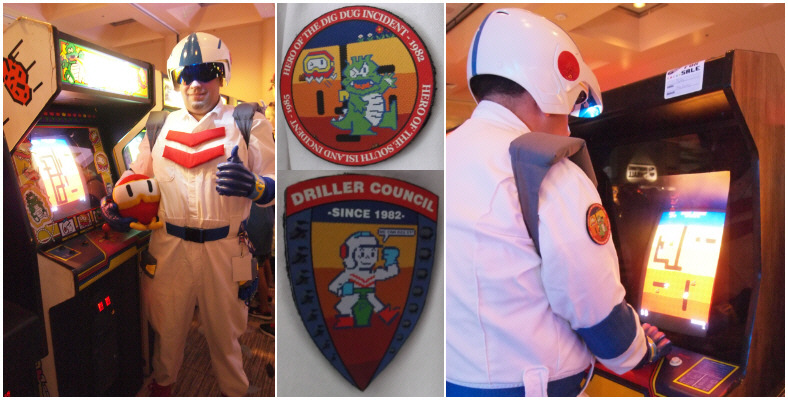
A tremendously huge thanks to the Extreme Team, exhibitors, volunteers and everyone else who comes together to host this show every year! In the nine consecutive years I've attended, this show is always a blast and I have a great time. It should be understood that although there are a lot of video game shows and conventions these days, including other huge arcade shows around the world, California Extreme really has a grass roots feel to it. California Extreme truly is the small arcade show that got really big but still keeps that aesthetic of a bunch of people lugging their games into a room and saying, "Hey, come have some fun!" I cannot wait until next year, thank you again!
More information about California Extreme
can be found at http://www.caextreme.org
|
I've said many times that I never got into what is termed as "retrogaming" specifically because old games appealed to me. Games that I liked were just as enjoyable after the release of a new piece of hardware as they were before. It's the genuine enjoyment of the games that kept my Atari 2600 Jr. right along side my Nintendo Entertainment System as I set up my Super Nintendo on my eleventh birthday. As much as we all chased after "the next big thing," the games that already existed never diminished in attraction, at least to me. The early 1980's retail game industry also didn't implode around me as it did in some parts of the United States, as I can distinctly remember buying copies of Haunted House and Spider Fighter from Sears in what must have been around 1986. Even as Nintendo was growing their market share with widespread distribution of the NES, there were still plenty of Atari 2600 games to buy at retail locally, most of which were outstanding games I play to this day. The Atari 2600 releases of Kangaroo, Mario Bros, Keystone Kapers, Pole Position, Ms. Pac-Man, Jungle Hunt, Midnight Magic and many more were all bought new at retail in the late 1980's. In fact the only oddity I can recall when it comes to Atari in that time frame was that my copy of E.T. the Extra-Terrestrial was purchased without a box. One of the local Kay-Bee Toys locations had a bin out in front of the store filled with them. All just the cartridge and instruction booklet in a clear plastic bag, for $2.00 each. Looking back I can only assume it was returned stock that either Kay-Bee or Atari were liquidating. If anyone out there recalls liquidating E.T. cartridges in Silicon Valley Kay-Bee stores in that fashion, send me an e-mail!
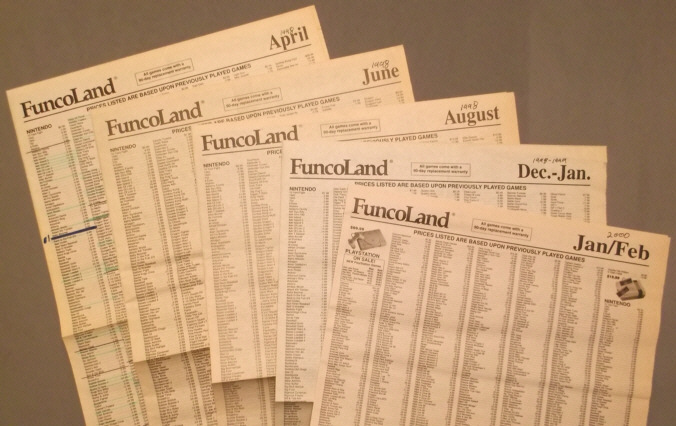
Some of the FuncoLand
price listings that I kept over the years. If you have any of these,
e-mail me, I want to buy them!
It was with FuncoLand's expansion into Northern California in the mid 1990's, I that I began what I suppose could be considered "collecting" video games. They used to publish monthly price lists on newsprint that they distributed through their stores. In the days before solid release listings (at least outside of Japan), or Internet access for the masses, these price sheets were how you could keep up on what you had and what was out there. For the most part the games were dirt cheap and the stores were absolutely filled with them. So around 1996 or so I would take a FuncoLand price list and highlight games I wanted to pick up. There were so many! So many games I remembered seeing in stores, reading about in Nintendo Power or that were very early NES releases that had disappeared by the time I had the hardware, which was Christmas of 1988 if I remember correctly. I would take my "reference" list in to a FuncoLand store, grab the current price listing, and looking over the two I would tell the "FuncoLand Game Advisor" that I was going to name off a bunch of NES cartridges. If they had it, I wanted it, if they didn't then I would continue down the list. The FuncoLand employees I did regular business with were some of the most awesome retail professionals I have ever encountered and greatly influenced my professional attitude to this day. After about thirty or forty dollars worth of games I would stop and make my purchase, generally leaving with twenty to thirty games - sometimes to the bewilderment of other customers in the store.
At the core of all those FuncoLand dealings was the search for a single game, Bandai's Dragon Power, a reworked and trimmed down localization of the first Famicom Dragon Ball game. When I was nine years old we had a robbery and other than our VCR and some jewelry, all but four of my NES games were stolen. Why four were left behind is unknown but the burglars took my copy of Tetris out of the console yet left the console behind. Three of the four games they didn't take were Jeopardy!, Cobra Triangle, and Skate or Die - I've never been able to remember the fourth. Just like that, fifty or so games - the culmination of years of birthdays, holidays, and saving pocket money - gone. The NES was still in its heyday so I would continue to receive new games for the system in the future but the robbery left a definite hole. For whatever reason Dragon Power was at the bottom of that hole, probably because Dragon Ball was becoming super popular in the USA, right around when FuncoLand stores were popping up around me. No one seemed to believe me that there was a Dragon Ball game released in English way back before it had any brand recognition outside of Japan. I wasn't really looking to rebuild my entire NES library initially, I was only looking for a copy of Dragon Power. I wanted to play it again and I wanted to show it to my friends. Eventually I would find one at a FuncoLand after a few years, for $2.99, but that game lead me down a path - the path to unintentionally "collecting" video games.

Dragon Power for NES.
Yes, this strangely localized and mediocre game is more or less the reason
why I began collecting video games.
It must be said that as a broad spectrum period of time, the late 1990's were in my opinion the greatest era for video gaming as a whole, specifically 1998. Whatever you wanted to play at the time was affordable and easy to find. If you wanted to play older games there were many mom and pop stores and chains such as FuncoLand that carried them. Two huge retrogaming communities, Digital Press and Atari Age, offered spectacular discussions and trading on their respective forums and both championed retrogaming as being actively engaging and entertaining. Retrogames weren't yet that old at the time and yard sales, flea markets and the like were often thick with low cost games and hardware. Great deals and classics for pennies on the dollar of original value were the rule, rather than the exception. The current gaming of the time was filled with an insane amount of variety. Not since the North American surge of the NES was the world more in love with video games, and a video game company, as they were with Sony's original PlayStation. By 1998 new PlayStation consoles could be had for $139.99 and with the genius of Sony's "Greatest Hits" campaign, one could pick up some of the best games of the generation, and of all time in some cases, for $15 - $25 each. It was a pretty amazing time to be interested in gaming as a whole and the culture of the time facilitated and promoted, possibly more than any other period in gaming history, that games were meant to be fun and meant to offer something to everyone. In 1999 I graduated from high school and made trips to FuncoLand every couple weeks and hit yard sales and the local flea market weekly over that summer. By early 2000 I was working a full time job and had a ridiculous amount of spare income. It allowed me to purchase hardware I was curious about but never had the opportunity to really get into such as the TurboDuo and Sega Saturn. Region modding of the Saturn lead me down the path of import gaming and console repair and restoration, something I really enjoy to this day.
In 2008 I relocated back to Silicon Valley after some years away. Although my old haunts were now out of reach, I found a couple places I could consistently find games for a few years, including a flea market vendor I had done business with for over a decade across two cities. However local access to games began to dry up as values climbed online and general inventory, as in neighbors and yard sales with massive amounts of games, dried up after years and years. It was then I began to massively reduce the size of my video game collection, including the majority of the printed or promotional materials I had gathered over the years. While it would be neat and tidy to say the reduction was due to a specific reason or new interest in another hobby, there is no singular reason for the exodus of what once filled bookcase upon bookcase and any place I could fit a storage bin into. There's no denying it, video game collecting is a completely different beast than it was ten to fifteen years ago. Retrogaming is an industry unto itself in the current era and although you can find almost any video game for purchase online, that convenience comes with an added monetary price and a competitive collecting and resale culture. Often times the assumed monetary value and a growing mentality of collecting over playing can make retrogaming en masse feel more like a business rather than a hobby for some. Although my core reason for playing video games has always been to find enjoyment and have fun, the weight of the more "brute force" collector culture of buying everything at any price soured things for me a little. It wasn't right that it bothered me, so I decided it was time to split my inventory down a little and concentrate on the games I really enjoyed or wanted to explore more and with that I began down another path.
TurboGrafx-16 stuff was selling for outrageous prices, not as outrageous as most of it goes for now, but way more than I paid for any of it and enough money to the point where I felt foolish for hanging onto any of it outside of a few games. So over a few years I sold my TurboDuo and all its games except for a few PC Engine (which was the Japanese console the TurboGrafx-16 was localized from) games that we're both games that I liked and had little value. My boxed complete Vectrex and a bunch of complete cartridges? Well it seemed that the console was going to need to be serviced soon and I hate working on monitors - especially ones that really were never meant to be serviced, so out the door it went. NES games were constantly spiking in value and most of the games I bought for between two to five dollars at yard sales and flea markets. Power Blade 2? That game sucks but now someone will pay me almost $200 for it? Sure thing! My Twin Famicom that I got a great deal on but rarely played? Dirt common Mega Man, Contra, and Castlevania games? You'll pay me how much?! Sold! When you're making hundreds on the dollar on stuff you bought at flea markets years before, it becomes hard to say no to mass liquidation and the prices on some of it are even higher now. A good amount of my games and larger accessories went to a local retrogaming store to bolster his inventory. That gentleman embodied old school collecting and video gaming. He bought and sold at fair prices, made you feel completely welcome in his store, and always had a rotating inventory. However even he left the video game business last year, concentrating on tabletop gaming instead. His reason being that there was just too much money wrapped up in it all. He couldn't bring himself to sell NES hardware for $70 or explain to people why he wouldn't pay them $90 cash for one they wanted to trade in. He saw selling a Sega Saturn setup to someone for $100 too big of an investment. During one of our last conversations before he closed up the game store we were talking about how if a couple years before you saw a Sega Saturn console at flea market for $30 you would leave it behind, as that was too expensive at the time and not worth the risk. If he priced things to what he deemed was fair, a reseller would just come in and drain his inventory and empty shelves don't keep people trading inventory into a store. I was actually in his store the morning before someone came in and bought him out completely during the last days and picked up a bunch of untested hardware: two Model 2 Saturns, a Master System, Jaguar with a controller, PSOne, and an original Xbox. Upon getting the Xbox home and opening it to clean it I noticed it had a 500GB hard drive and was soft modded - that lead me down another path.
Xbox modding is something I was always interested in but never really put the time behind. I was involved in some Dreamcast emulation and development projects and ran myself ragged of the whole thing on that console. Turns out the real fun was to be had over on the Xbox. The modded Xbox I bought by accident allowed me to see first hand how the softmod worked and how to structure applications and to get my feet wet with nothing more than a $5 risk. Console emulation on the Xbox isn't perfect but it's pretty darn spectacular with what you can play and how nicely it can all be served up. I will say that I have discovered more games and played more fan translations to completeness on a modded Xbox than I have in the past ten years. It hit at just the right time and scratched the retrogaming itch enough that the big time reduction in games and hardware didn't feel so bad. While I got rid of a lot of stuff, I still do have quite a few games and lots of hardware but it's all manageable and playable now. It's fun again and that's what it's supposed to be about, at least to me. I also had some amazing runs of luck this year. I bought another Twin Famicom from an eBay seller in the USA for a spectacular price. It was listed with a non-working Famicom Disk System drive, which is normal and should be expected as the drive belts generally need to be replaced. When the console arrived it turned out the belt was fine, the multiple wiring harnesses that connect everything together simply needed to be cleaned (as did the whole console as it was filthy) and reseated. After that it worked 100%.
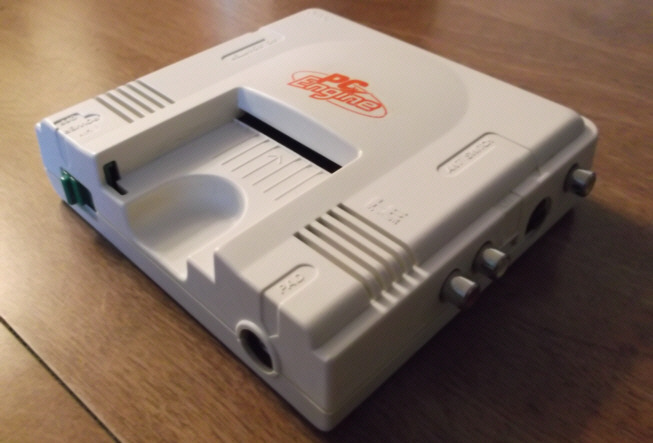
This PC Engine had been
through a seawater flood but after some restoration work it is beautiful
once more.
I bought a severely seawater damaged PC Engine console from a dealer in Japan I do a lot of business with and was able to restore it completely. This was my second PC Engine, the other I purchased a few years ago for a few bucks at a local anime convention. The plan was then to sell my remaining TurboGrafx-16 and region mod one or both of the PC Engines so I could use it for TurboGrafx-16 games. In addition to the console redesign, the TurboGrafx-16 also changed the controller port size however the PC Engine had a ton of different controllers released for it and extension cables are really cheap, so I prefer it over the TG-16. While researching which of the region mod boards I wanted to use I ended up buying another damaged PC Engine from the same dealer and was able to restore it as well. Looking at the flat out crazy prices TG-16 games are still going for, I made the decision that instead of region modding a PC Engine I would instead buy a TG-16 / PC Engine flash memory cartridge, which I could purchase for the price of selling two TG-16 games. A flash memory cartridge is a game cartridge that uses configurable media containing the program code of a game, usually in the form of an SD memory card. Basically you can have a console's entire library on a single cartridge and then play the games on actual hardware. The funny thing is that I got into the PC Engine both for its exclusive games (tons of outstanding shooters) and its cheaper Japanese versions of expensive TG-16 games. However even the PC Engine market is starting to climb in value and get out of hand. I do keep my PC Engine stuff pretty liquid, buying and selling games from time to time on a fairly regular basis but that may change once I start using the flash cartridge. I'm sure either way it'll lead me down another path in retrogaming.
At the end of the day I believe that is
what is most important, to be open to changes and new experiences, especially
with these old games and then have some fun. Having that flexibility,
letting go of some games so that others can be better enjoyed. Drifting
off to other hardware and areas of collecting and gaming that may have
not been initially interesting. Realizing that there is so much out
there to play and experience and above all, enjoying the journey.
I can honestly say that if I never decided to mix up my collection that
seven or so years ago it would probably mostly still be collecting dust
or be packed away in storage bins. These days I may have a lot less
on the shelves but I play a lot more games and that's what it should really
be all about - playing games and having fun. That's how it has been
working out for me lately anyway. Video games are something different
to everyone and that's the reason I consider them the universal entertainment
medium. Follow your own path that allows you to get the most enjoyment
out of the games that you collect and be willing to make a change if one
presets itself, you never know where it may lead.
|
TriForce is the founder of the development organization and eSports team "Empire Arcadia." His eSports brand has recorded more documented tournament victories than any other team in the history of competitive gaming. He is a retired professional gamer and played games such as Vs. Super Mario Bros., Tetris, Black Tiger and more. TriForce is famous for being the first person purchase a new Nintendo system such as the Nintendo DS, Wii, 3DS, WiiU and other games associated with it at the Nintendo Headquarters in New York. He has waited up to as much as 30 days outdoors to be the first one to receive a Nintendo product. I introduce to you a legendary Nintendo gamer, TriForce "GameMaster." I asked TriForce some questions about his life and career and the future of ESports in the world today.
Where did the name "TriForce" originate from?
Back in the days we all had our gaming tags for the arcades. Mine was "TGM", it means "The Game Master." A lot of my gaming friends did not like to call me that name. They decided to rename me because they felt "The Game Master" was a title and not a name. Secretly... many of them didn't like it because they thought they were better than me. They decided to call me TriForce after so many failed attempts at other names because they knew my love and passion for the Legend of Zelda. I decided to stick with TriForce because I believe that Power, Courage and Wisdom describes me as a person.
Where are you currently living these days?
I'm all over the place honestly. With my ambitions in eSports, I travel a lot. I'm either in Jamaica, the Caribbean, numerous states throughout the United States or somewhere overseas.
Other than the Legend of Zelda, what are some of your favorite retro classic games?
Tetris, Super Mario Bros., Contra, Castlevania, Mega Man and so many more on both the NES, SNES and Sega Genesis.
Other than gaming, what are some other hobbies of yours?
First of all... gaming stop being a hobby for me in 2000 when I first got my ambition to make an eSports team. In 2002, I did exactly that with Empire Arcadia. Since then... I have no hobbies. Empire is my life. Sounds crazy... but I find that all I do is work to push Empire Arcadia. Despite that, I'm happy with my life and that's what matters most.
What are your most popular retro games to compete with and what games of today are the top choices?
Well as you know Donkey Kong is still the most popular retro game to compete in today. Other notable retro games are Ms. Pac Man, Defender and Centipede. As for today's games, the top choices are League of Legends, Call of Duty, Dota2, Super Smash Bros. Wii U, Street Fighter V, Counter Strike and FIFA.
How do you compare the competitive games for the 90s to the games of today?
It is very difficult to make the comparison. Each of the ages in competitive gaming, aka eSports had different communities, technology and platforms. That in itself makes all the difference. For example, during the 80’s I had to go to the arcade, pop in quarter after the quarter, standing up in less than comfortable conditions to play a game. If I made one mistake that game was over and I had to wait until when it was my turn again to play and try to master the game. The room for error was non-existent.
In the 90’s that strict pressure diminished greatly. I don't even want to talk about today... ugh! That pressure doesn't even exist at all. Today's gamers don't know how good they got it. The level of discipline it took to master a game or get a world record back in the day compared to today cannot be compared. That may come off snobbish but consider the following testament. In 2011, I went to Richie Knucklez arcade in the winter and I slept on the floor in his arcade for 2 days trying to master a strategy in a game to get a world record. Each time I messed up, I had to kill off all my men and start all over again. The grueling and tedious attempts in cold takes a huge toll on your mind, body and soul. I'm not exaggerating either. At the same time however it teaches you discipline. We're not even going to go into the amount of money that was invested just to get the record. All of these things come into play when going for a world record that does not exist in today's time.
We heard you retired from competitive gaming, why?
Well honestly, there is more to competitive gaming than just competing. Things have changed for me drastically anyway. My eSports team needs me at the helm, not competing in retro and modern eSports tournaments. That in itself was a huge stress on me. On top that, I have to then manage the team and conduct business. The way things are in terms of competing I'm not in a comfortable position to manage that level of stress and be able to compete both in retro games and modern games. I once was able to deal with that pressure but that type of stress I can do without.
Back then, whatever technique or strategy I came up with I could use that exclusively because I created it or earned it at the arcade combating against another opponent. Today's retro players have YouTube. All the work you did is to your competitors benefit. Secret tech? Secret strategies? The word secret doesn't exist anymore. This is problematic even in modern eSports. A world class pro fighting game player by the name of Tokido says he doesn't play online. People "download" your fight style. For those that don't know, it means study your game play and build whole strategies around it. They don't adapt in the middle of the match which would show the true skill of the player. Give anyone prep time and they can beat you.
It's one thing if you go home practice, bring you "A" game vs. another person's "A" game and let the cards fall where they may. It's another when a person knows your game plan and creates one to counter it while you on the other hand now are stuck in the position of finding a counter to that, with no prep time. You have to do it right there and then. Is that fair? I think not. Can you image that but with classic games? Oh man... the stories I hear from the legends on how today's gamers literately carbon copy and use their strategies plus new and improved, just to come up off their name. Nope... not me. I'll just retire and put my focus elsewhere. Which is what I did.
What about your world records?
What about them? I don't want to undermine my own achievements in competitive gaming both retro and modern but there are a number of things that I considered regarding my world records. First, records are made to be broken. We all have egos, some bigger than others. My ego is not as large as many might believe. I knew when I was setting my world records that eventually someone might beat some of them and I'm personally fine with that, regardless if the person is better than me or not. It's not like I'm going to lose all my world records. I have about 9 or 10 maxed out world records. You can only tie them. So I'm going to the grave with those.
Let's look at another point regarding records. Many of my records are "inaugural." Records that I put up just to bring notoriety to games that I think deserve the attention and showcase my skill set as a gamer. Anyone who beats my records will tell you what type of gamer I am to have put them through that hell. (Laughs) For me, some of these games I grew up on so I just have a natural skill at being great at them so I set a record for it. Unlike other people, I don't go chasing down a establish name to a record so I can make a name for myself. A lot of people do that even in modern eSports. This is going to rub people the wrong way but a lot people do this. That's an ego issue. Like I said... my ego is not that big.
Finally, adding to my last point, these records are for me. It reminds me of my childhood and I do it to leave a mark that I was a contributor to the retro eSports age. It's like building a resume as a competitor and then I use that to help contribute in other areas of the eSports. My world records gives me the weight of prestige and legitimacy to my stature in the scene. What other CEO of any eSports team now and then do you know that has a bunch of world records along with winning tournaments in both retro and modern games? Respect is given to those that lead by example. I have this saying, something I always say to the members of my eSports team; then and now. "It's not about what you win but what you do with that win."
A lot of players set a record or break one and that is all they've done. They'll get an article or two, interview or two on the associated sites regarding that game or age and that's it. Fade away. I'm about doing more with my accolades and helping the scene and culture behind competitive gaming. This is more than just about me. It's a privilege to play video games and any benefit that I can get from it I need to use it to contribute back to society in a positive way or it isn't worth doing it to begin with.

What is your number one world record you hold above any other world record you have?
This may come as a shock to you but this is the main supporting reason why I retired. My #1 record isn't even my own personal record. It's a record I share with my eSports team, Empire Arcadia. That record is "The Most Documented Tournament Wins for a Gaming Team." That record stands at 2,000 plus wins. I won the 2,000th tournament for our team to get that record from Guinness World Record in 2015 and retired on that win, going 20-0 at the Cyberbox eSports League.
The focus for myself competitively has greatly diminished, I care more about the team so that is where my focus is. I could lose all my personal records, it wouldn't and doesn't bother me. I don't even play those games anymore so it's expected that I will lose them over time. During the time I did play them and had the records I was the best and I held it down against some of the world's finest. That's good enough for me. Let's make the comparison of Michael Jordan and Steph Curry. Steph's team beat the Bulls 72-10 with a 73-9. Although they didn't win the championship, they beat the Bulls regular season wins. Does that take away from Jordan's greatness? Nope.
Knowing this I'm secure with myself because when I was playing no one did beat me then and that says a lot about my personal ability as a gamer. Be that as it may, right now it's about passing that mindset and philosophy to my players so that they can protect the eSports Dynasty that I help build. I take great pride in that team accolade and am happy to share it with my teammates and future teammates to come.
Do you remember your first competitive game tournament and what game was it for?
My first ever competitive gaming tournament was in Karate Champ in Joe's Pizza on 233rd and White Plains Road, Bronx NY. I had a 53 game win streak after I won the tournament. Now if you're talking about with my eSports team Empire Arcadia, then it was Tetris at Magfest in 2003. The event wasn't even called Magfest at the time either.
How long have you been part of Empire Arcadia?
Empire Arcadia was a community that goes all the way back to 1984 when we called our community "Videoland." Yes... before Captain N: The Game Master. Crazy enough our community GameMaster was called Kevin as well. Light skin brown hair kid. Yes, it's just a coincidence. It's just crazy how similar it was when I saw it on TV. I actually thought Nintendo hired Kevin. He told me it wasn't him and had nothing to do with him, it was just a random coincidence. Anyway... If you're talking about the eSports team however, then we'll have to count from when I formed it in 2002 to the present. So that is 14 years.
Who has been your longest member of the team?
The longest standing member is Jeron "Hiro" Grayson. Veteran world class Street Fighter player. He plays every single Street Fighter competitively. He's been in the team for 13 years and going. We've been friends him since 1997.
How do you compare today's team with the first generation of players?
I don't think you can compare today's team with the first generation of players. Different mindsets, technology, behaviors and interests. The only thing that is similar with most of today's players and teams in comparison to the first generation of players, is that each could care less about anything outside of their games and players.
What was the thinking behind the name "Empire Arcadia?"
The concept behind the name "Empire Arcadia" was about making an empire in competitive gamers that originally stemmed from the arcades. It was to pay homage to Walter Day's Twin Galaxies and migrate the arcade gamers into the new age of eSports. I didn't want our culture and heritage to fade away so I built an empire that eventually turned into a dynasty to safe guard it.
How important to you is being on top of the gaming world?
There are many mountain tops in the gaming world. However since the focus has been about eSports. It's important for our team to maintain its position as a dynasty in eSports because our goal is to protect the heritage, culture and the history of the community in competitive gaming i.e. eSports. It's not just about winning, it's about what we do with it. There is an obligation and responsibility that we have to the scene. Our goal is a lofty one and in order to fulfill the mission, it requires us to be at the top.
What is the mission of Empire Arcadia?
Empire Arcadia's mission is to utilize the professional talents and experience of its World Class Championship brand for the benefit of developing new markets in the growing video game industry, community and culture. The organization looks to develop these new markets in gaming through various diverse elements such as Fashion, Art, Music, Media, Health, Education, History, Community Network, Technology, Competition and Entertainment in gaming.
What current games are you and your team playing and competing on?
As I mentioned before, I'm retired. Although I am brushing up on Tetris skills for a feat that I'm going to be doing for Guinness World Record to promote the launch of their new Guinness World Record: Gamers Edition 2017 Book. I have to represent the #GWRgamers out there. As for the players on my team, they play everything. Retro, FIFA, Fighting Games, Multi Online Battle Arena, First Person Shooters, HearthStone; the list goes on. You name it, EMP plays it. In the immediate future we're putting together an Overwatch team.
Were you ever involved with PC competitive gaming and if so, what games?
I played PC games competitively before. Command and Conquer, Unreal Tournament, Quake, Duke Nukem, World of Warcraft PVP. I wasn't great. I got demolished once I stepped into the upper echelon.
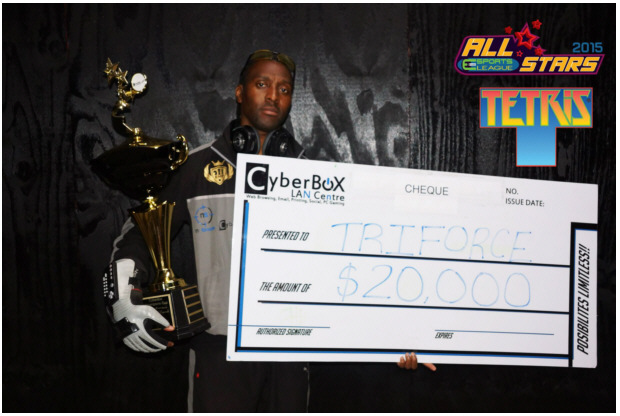
What does eSports mean to you and how has it influenced you as a person?
Competitive gaming means a lot to my goal but it has no real influence on me as a person. It's just a path I'm taking to get into a position of power where I can gain resources and wealth so I can compete in the real game and that is the game of life. I want to be able to help people around the world who cannot help themselves. Especially my own people who are suffering globally via poverty, famine, social, economic oppression and more. I don't really want to get into that so I'll leave it right there. As what influenced me as a person, my Father.
Where do you see eSports and organizational gaming in the next 10 years?
I see eSports where sports is today in 3 years. Yes... I said 3. You can forget about the 10. There are people at work are in power that are not going to wait that long. I'm one of them. eSports is three decades late as it is. It should have been further than this ages ago.
What advice do you have for younger kids who want to get involved in eSports?
Stay in school. No one wants a dunce who can't read, write or spell. No we don't care how good you are in the game. If anyone won't keep it real with you, I will.
How do you get and obtain sponsorship for your team? Who has been your longest sponsor to date?
Obtaining a sponsors is kind of difficult. It's all about marketing. If you don't have a player, brand, product or service to market to or for your sponsor, forget about it. Our longest standing sponsor is Noscople Glasses. We're about to onboard a new Sponsor called "Catalyst Mints". It's an energy product for gamers in the form of a mint.
What documentaries are you a part of and is there any coming in the near future?
I just finished a screening for the documentary "The Power of Glove" at MAGFEST, early this year. There is another one called "No Princess in the Castle." However the one I have my focus on the most is "TRIFORCE." It's a documentary done by Jack Schurman and it is the real gritty look at my actual life in and outside eSports. I'm also in talks with the History Channel about a very important documentary in which I may be a part of. I'll have to wait and see.
So what's next for you and Empire Arcadia?
Since my retirement in 2015, my focus has
been on expanding our eSports brand in underdeveloped and underrepresented
region of the world that are either looking to get into eSports industry
or has a poor infrastructure and needs help. It's why I've been traveling
so much, especially in Jamaica. This has kept me extremely busy and productive.
It makes me tremendously happy and validates my contributions to the eSports
universe as a whole.
|
A few months ago I was reading an article from 2014 at Book Riot about mating bookstores with bars and how they are "great for the community" as "they encourage curious readers, provide another venue for local arts, and connect the great pastimes of social drinking and introverted reading." That final line made me grit my teeth as it's precisely what became of most arcades in the United States and how many video game arcades here survive today.
I sarcastically considered bookstore-bars as a great idea, and proposed that all other bookstores should be closed as they're "no longer viable to foot traffic," "you can read the same books at home or these days on your phone," and because "no one is going to pay that much for something they can get for free," and then only have bookstore-bars. Even libraries should be closed or converted, renamed as "Barbraries." Make sure you trademark that generic name though, as you wouldn't want the competition using it as well! Then whenever you want to read a book using the genuine article, you would have to go into a place crowded with what modern media terms as "hipsters" and frat boys slamming down $8 draft beers. Now I know what you're saying and yes, there will still be "family bookstore centers." However they'll basically be filled with flashy magazines, mostly comprised of just advertisements, that take your money under the guise of featuring content. It's okay though, every ten magazines you buy can be traded in for a small kitschy prize at the front counter on your way out.
That can't happen, you say? Ever heard of a Barcade? That's exactly what happened to the arcade industry in the United States. To that I say, "Go drink elsewhere dude, I just want to play Gyruss." And I'm sure most of our readers have figured out that the "family bookstore centers" are stand-ins for "family fun centers," which are generally filled with redemption games that steal your money so you can trade in earned tickets for some plastic doodad that will wind up in the trash ten minutes later. What's your take on Barcades and the mating of video arcades with other forms of entertainment as their primary money earners? Let us know on our Facebook page!
Thank you once again for checking out The Retrogaming Times. We'll be back on November 1st with our next issue, the last one of 2016. Be sure to follow The Retrogaming Times on Facebook and join our new community! I sincerely hope you enjoyed this issue and that you will return to read the next issue and possibly submit an article yourself. Remember, this newsletter can only exist with your help. Simply send your articles directly to me at trt@classicplastic.net or check out the submission guidelines on the main page. Submit an article today and join a great retrogaming tradition!
See You Next Game!

Content and opinions on this
page are those of their respective writer(s)
Assembled and published
by David Lundin, Jr. on September 1st, 2016 at ClassicPlastic.net
© 2016 The Retrogaming
Times. All Related Copyrights and Trademarks Are Acknowledged.